|
Situated between India and China, Southeast Asia has been the
birthplace of several cultures, some of which rank among the world’s greatest
civilizations. Among the Indianized kingdoms which sprang up in Southeast Asia
before the Common era, the great Khmer civilization and its
capital, Angkor, in modern day Cambodia. The advent of Indians in Southeast Asia
has hardly a parallel in history. In view of the ethnic affinities between the
prehistoric Austro-Asiatic races of India and those of Suvarnabhumi, contact
between the two regions may well go back to the remotest antiquity.
Most of the countries of Southeast Asia came under the
cultural and religious influence of India. This region was broadly referred to
by ancient Indians as Suvarnabhumi (the Land of Gold) or Suvarnadvipa (the
Island of Gold). Vedic Indians must have charted Java, Yawadvip, thousands of
years ago because Yawadvip is mentioned in India's earliest epic, the Ramayana.
The Ramayana reveals some knowledge of the eastern regions beyond seas; for
instance Sugriva dispatched his men to Yavadvipa, the island of Java, in search
of Sita.
Southeast
Asia was often called by many British, French and Indian scholars as Farther
India, Greater India, L’Inde Exterieure, and the Hinduized or Indianized
States. The
whole area was so influenced by India, that according to a European scholar who
wrote in 1861, that "the Indian countries situated beyond the Ganges hardly
deserve the attention of History." The various states established in
this region can therefore be called Indianized kingdoms. Invasion nor
proselystism was by no means the main factor in the process of Indianization
which took place in the Indian Archipelago. International trade was very
important.
Angkor Wat indeed deserves to play the
leading part not only because of its exceptional artistic and architectural
achievements but also on account of the hydrological, agricultural and
ecological problems solved there.
Angkor
wat is
often hailed as one of the most extraordinary architectural creations ever
built, with its intricate bas-reliefs, strange acoustics and magnificent soaring
towers.
Angkor
Wat, originally named Vrah Vishnulok - the sacred abode of Lord Vishnu, is the
largest temple in the world. It was built by King Suryavarman II in the 12th
century.
The
Sanskrit Nagara (capital) was modified by the Cambodian tongue to Nokor and
then to Angkor.
The word Angkor is
derived from the Sanskrit word 'nagara' meaning 'holy city'. Vatika is Sanskrit
word for temple. "The city which is a temple," Angkor Wat is a
majestic monument, the world's largest religious construction in stone, and an
architectural masterpiece. The
Khmers adhered to the Indian belief that a temple must be built according to a
mathematical system in order for it to function in harmony with the universe.
Distances between certain architectural elements of the temple reflect numbers
related to Indian mythology and cosmology. The
sheer size of the place leaves visitors in awe and the complex designs
illustrate the skills of long gone priest architects. Every spare inch has
been carved with intricate works of art.
The sculptures of Indian icons produced in Cambodia during the 6th to the 8th
centuries A D are masterpieces, monumental, subtle, highly sophisticated, mature
in style and unrivalled for sheer beauty anywhere in India says Philip
Rawson. The
scale of Angkor Wat enabled the Khmer to give full expression to religious
symbolism. It is, above all else, a microcosm of the Hindu universe.
It is frequently said that Angkor
was 'discovered' by the Europeans but this is patently nonsense and simply
reflects a Eurocentric view. The Khmer never forgot the existence of their
monuments. French naturalist Henri Mouhot stumbled across
the city complex of Angkor Wat while on a zoological expedition. He was overwhelmed by the magnificence of these ruins hidden
in the jungle and wrote:
“One of these temples – a rival to that of Solomon, and
erected by some ancient Michael Angelo -
might take its place besides our most beautiful buildings – Grander than
anything left to us by Greece or Rome …it makes the traveler forget all the
fatigues of the journey, filling him with admiration and delight, such as should
be experienced on finding a verdant oasis in the sandy desert."
The grandeur of this ancient civilization is truly
astounding. Covering an area of one square mile, Angkor Wat is one of the
largest temple complex in the world. The temple is dedicated to the Lord Vishnu
from whom the king was considered a reincarnation. Essentially a three-layered
pyramid, Angkor Wat has five distinctive towers, 64 meters high. On the outer
wall are eight panels of bas-relief depicting scenes of Hindu epics Ramayana and
Mahabharata. These relics of past grandeur bear mute testimony tone of the least
known yet most glorious chapters in the history of mankind: that of the
classical culture of ‘Greater India.’
Unlike
other countries, Cambodia does not minimize Indian influence on the local
culture. On the contrary, the people of the country generously acknowledge it.
Prince Norodom Sihanouk of Cambodia recalled the close cultural ties that have existed for
two thousand years between India and Cambodia. He said: "When we refer to
2000 year old ties which unite us with India, it is not at all a hyperbole. In
fact, it was about 2000 years ago that the first navigators, Indian merchants,
and Brahmins brought to our ancestors their gods, their techniques, their
organization. Briefly India was for us what Greece was for the Latin
Occident."
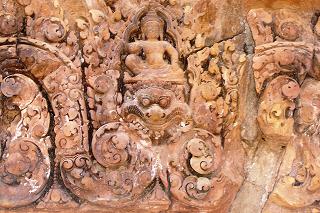

Introduction
Angkor
Wat: Symphony in
stone
Background of Vrah Vishunlok
Breath
Taking Carved Bas-Reliefs
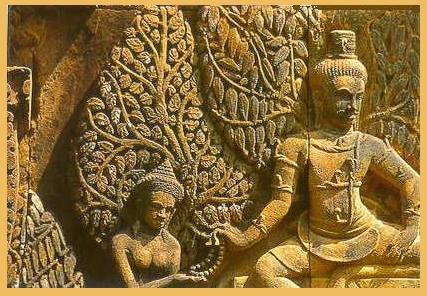
© Michael Freeman
For the rest of
the chapter refer to the links listed below:
Sacred
Angkor part 2
Sacred
Angkor part 3
Sacred
Angkor part 4
Introduction:
 Jon Ortner
( ? ) author of Sacred Places of Asia: Where Every Breath Is
A Prayer has remarked: Jon Ortner
( ? ) author of Sacred Places of Asia: Where Every Breath Is
A Prayer has remarked:
"As
I walked along the huge, ancient stone of the causeway leading to Angkor Wat, I
was forced to look inward and question my own significance in the universe.
Everything here, from the huge moat protecting the complex to the giant nagas
flanking my path, is designed to make one shrink before the majesty of
Vishnu.
"After passing through a succession of courtyards, each grander and more
elaborate than the last, I arrived at an enormous Meru with its five soaring
peaks and exquisitely carved walls. What a spectacle this all must have been
long ago....Angkor Wat is the representation of the Khmer universe, reflecting a
relationship to nature on such a deep level, that it makes modern architecture
seem spiritually empty. The soul of the Khmer is alive in these temples and
mirrored in the faces of today's Cambodians, the recipients of a rich artistic
and spiritual heritage."
(source:
Sacred Places of Asia: Where Every Breath Is A
Prayer - By Jon Ortner p. 113).

Lord Vishnu: 12th century bronze housed in Phnom Penh Museum.
Everything here, from the huge moat protecting the complex to the giant nagas
flanking my path, is designed to make one shrink before the majesty of
Vishnu.
The sculptures of Indian icons produced in Cambodia during the 6th to the 8th
centuries A D are masterpieces, monumental, subtle, highly sophisticated, mature
in style and unrivalled for sheer beauty anywhere in India. - says Philip
Rawson.
(image source: Angkor:
Splendors of the Khmer Civilization - By Marilia Albanese p. 77).
***
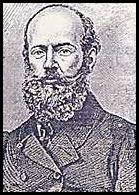 Henri
Mouhot
(1826 -1861) a French naturalist and explorer, who had gone to South-east
Asia in the late 1850's and succumbed to fever there in 1861. Mesmerized by what
he saw at the temple of Angkor Vat, Mouhot in lyrical descriptions said: Henri
Mouhot
(1826 -1861) a French naturalist and explorer, who had gone to South-east
Asia in the late 1850's and succumbed to fever there in 1861. Mesmerized by what
he saw at the temple of Angkor Vat, Mouhot in lyrical descriptions said:
"At the sight of this temple, one feels one's
spirit crushed, one's imagination surpassed. One looks, one admires, and, seized
with respect, one is silent. For where are the words to praise a work of art
that may not have its equal anywhere on the globe? ... What genius this
Michalangelo of the East had, that he was capable of concaving such a work.''
(source: Le Tour du Monde, 2-1863-299).
He
said: "See Angkor and Die."
He was
staggered by his discovery. There was a city so vast and so sophisticated that
it must have been built by people with an advanced knowledge of engineering,
science, mathematics and art. The young Frenchman soon sent word back to Europe
telling of the most beautiful lost city ever to be discovered. The monumental scale, grandeur and beauty of Angkor justifies
its reputation as one of the world’s great creations.
Mouhot wrote: What strikes the
observer with not less admiration than the grandeur, regularity, and beauty of
these majestic buildings, is the immense size and prodigious number of the
blocks of stone of which they are constructed. In this temple alone are as many
as 1532 columns. What means of transport, what a
multitude of workmen, must this have required, seeing that the mountain out of
which the stone was hewn is thirty miles distant!...."
(source: Angkor:
Heart of an Asian Empire - By Bruno Dagens p. 140-141).
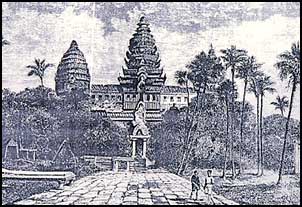
"It is
grander than anything left to us by Greece or Rome."
Henri
Mouhot was
staggered by his discovery. There was a city so vast and so sophisticated that
it must have been built by people with an advanced knowledge of engineering,
science, mathematics and art.
***
"It is
grander than anything left to us by Greece or Rome." "To obtain any
idea of its splendor on one must imagine the most beautiful creations of
architecture transported into depths of the forests in one of the more remote
countries in the world."
Mahout recorded excitedly in his
diary for January 1860 after gazing on the 200-ft temple of Angkor Vat.
(source: The
World's Last Mysteries - Readers Digest
ASIN 089577044X p. 243).
When he first brought it to the knowledge of the modern
Western world in 1860, the explorer, Henri Mouhot, said of it, quite simply,
“this architectural work perhaps has not, and perhaps never has had, its equal
on the face of the globe.”
(source: The Culture of South-East Asia - By Reginald Le May p. 133).
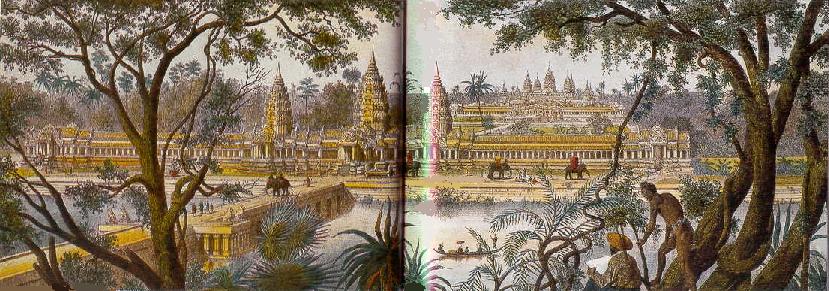
Splendid sweep of graceful symmetry.
Artist view of life in ancient
Angkor wat. A mesmerizing monument and the largest stone building in the world.
Louis Delaporte produced the official drawings for the
Mekong Exploration Commission.
(image source: Angkor:
Heart of an Asian Empire - By Bruno Dagens p. 52 and Angkor: Splendors
of the Khmer Civilization - By Marilia Albanese p. 57).
***
Henri
Mohout could hardly believe his eyes in 1860. He wrote of:
"ruins
of such grandeur, remains of structures that must have been raised at such an
immense cost of labor, that, at the first view, one is filled with profound
admiration....One of these temples - a rival to that of Soloman, and erected by
some ancient Michael Angleo - might take an honorable place besides our most
beautiful buildings. It is grander than anything left to us by Greece and Rome,
and presents a sad contrast to the state of barbarism in which the nation in now
plunged." To Mahout, those "prodigious works"
were nothing short of astounding.
(source: Splendors
of the Past: Lost Cities of the Ancient World
- National Geographic Society. p. 186).
At Ongcor, there are ...ruins of
such grandeur... that, at the first view, one is filled with profound
admiration, and cannot but ask what has become of this powerful race, so
civilized, so enlightened, the authors of these gigantic works?
(source: In
Mouhot's Footsteps).
 Francis
Garnier (1839 – 1873), the Deputy leader of Louis Delaporte and the
chronicler wrote of Angkor Wat: Francis
Garnier (1839 – 1873), the Deputy leader of Louis Delaporte and the
chronicler wrote of Angkor Wat:
"Perhaps
no where else in the world, has such an imposing mass of stone been arranged
with more sense of art and science...a spark of sheer genius....what grandeur
and at the same time what unity..."
Garnier’s
narrative and Louis Delaporte’s art
together resurrected Angkor Wat from ruin and decay to restoration and
eventually a World Heritage status.
(source:
Mekong
magnificent obsession - tribuneindia.com).
 Bernard
Philippe Groslier (1926 -1986) the great French conservator
and archaeologist discussing the genius of the Khmer empire, a
restless creativity that left scattered over thousands of square miles of
tropical forest some of the finest sculpture and architecture ever produced. To
Professor Groslier, Angkor wat was “the highest
architectural achievements of all Asia” Bernard
Philippe Groslier (1926 -1986) the great French conservator
and archaeologist discussing the genius of the Khmer empire, a
restless creativity that left scattered over thousands of square miles of
tropical forest some of the finest sculpture and architecture ever produced. To
Professor Groslier, Angkor wat was “the highest
architectural achievements of all Asia”
“They were the masters of their
world. It was quite wonderful. There was peace and order. Temples full of
riches. Happy Brahmins full of good rice, good food. And, of course, some of the
most magnificent temples ever built. Nothing in that part of the world would
compare. Nothing! That’s quite something, n’est-ce pas? – isn’it?”
"The
Khmer took everything from India, from irrigation to astronomy and including
Shiva and the rest of Hindu religion...And the Khmer built Angkor. "
“The expansion of India towards the countries of the East,
at the very moment when by a striking coincidence China seemed to be moving
southwards to encounter it, constitutes one of the turning points of
history…”
(source:
Splendors
of the Past: Lost Cities of the Ancient World
- National Geographic Society p. 184 - 190).
Groslier
who was the author of Angkor: Art and Civilization, describing the
incomparable perfection of Angkor Wat wrote:
"The Khmer civilization was the most important, the most
brilliant and original in ancient Indo-China. The brilliant achievements of
ancient Cambodia were due primarily to the country’s wealth of natural
resources. No other country of the peninsula could boast of such an unbroken
extent of fertile and well-watered. Cambodia, being a strictly defined and
admirably situated geographical unit, was the cradle of a powerful and gifted
race.
But neither favorable environment nor
limitless resources nor years of peace would have sufficed without the spiritual
contribution of India.
India was the spark that fired the
blaze."
(source: Angkor: Art and
Civilization - By Bernard-Philippe Groslier and Khmer:
The Lost Empire of Cambodia - By Thierry Zephir p. 114).
"There
is hardly anything in the world comparable to the Angkor complex in terms of the
number, size and perfection of its buildings."
"one
of the supreme architectural triumphs of all time. There can be no doubt that it
was conceived by one man, by the genius of a great architect. It is a
masterpiece without a successor." "All
these details, together with the size of the building which bursts into sight at
the end of the triumphal avenue and at every embrasure open to the view,
contribute to the impressiveness of Angkor Wat "
(source: Can
Angkor be saved? - Angkor Wat, Cambodia - By Frank Bequette
Feb
1994 and Sacred Places of Asia: Where Every Breath Is A
Prayer - By Jon Ortner
p.
109 and Angkor and the Khmer empire
- By John Audric
p. 146).
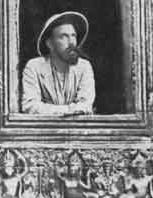

Charles
Carpeaux and Henri
Parmentier at
Angkor wat.
***
Charles
Carpeaux a photographer who worked with French archaeologist Henri
Dafour in 1901, wrote:
"Not an inch of this stone that
isn't carved with an incredible richness and a charming naivety of expression.
The fifty two towers, each adorned with four colossal heads of Brahma, are
capped with a tangle of creepers and even big trees....You can't imagine the
effect produced by these heads of Brahma, with the patina of so many centuries,
covered in lichen, enveloped in creepers through which rays of sunlight still
manage to filter, playing on these enormous figures and giving each a different
expression: some smile, others appear sad, yet others are impassive."

The
"mother of all temples" -- Angkor Wat.
A mesmerizing monument - No photograph can quite capture
the immensity of it.
"Let
it be said immediately that Angkor, as it stands, ranks as chief wonder of the
world to-day, one of the summits to which human genius has aspired in stone,
infinitely more impressive, lovely and, as well, romantic, than anything that
can be seen in China...
"The
flow of history and culture from India, across Burma and into Indochina is an
epic saga of history," Pran a guide at Agnkorwat.
(image source: greatbuildings.com).
***
Henri
Parmentier (1871 -1949) has observed the intricacy of details at Angkor Wat:
"This decorative minuteness is
pushed to the extreme; if one is stuck by the work and the formidable expense
represented by the ten kilometers of border chiseled sandstone of the moats, one
is no less stupefied when one thinks of the execution of the 10,000 ridge-crests
which are aligned on all the ridges, so delicate that not a single entire
specimen has come down to us."
(source: Angkor:
The Hidden Glories - By Michael Freeman and Roger Warner p. 182 -
190).
 Diego
do Couto (1543 - 1616) a 16th century,
Portuguese traveler became the first of many Western chroniclers to visit Angkor
and he express amazement at its prodigious stone
masterpieces, calling the city: Diego
do Couto (1543 - 1616) a 16th century,
Portuguese traveler became the first of many Western chroniclers to visit Angkor
and he express amazement at its prodigious stone
masterpieces, calling the city:
"one of the wonders of the world."
“Half a league from this city of Angkor Thom is a temple
named Angkor, which is built on beautiful, flat and open terrain. This
temple is hundred and sixty paces long and so strangely constructed that it
cannot be described in writing any more than it can be compared to any other
existing document. The central body of the building comprises four
naves and their vaults rise up, heavily decorated, to form lofty, pointed domes
supported by numerous columns worked with all the intricacy of which the human
genius is capable. The temple is built on a magnificent platform of massive
slabs of the same stone as the rest of the edifice. …These pointed towers with
their globes can be seen from more than four leagues away..”
"The
city is surrounded by a moat, crossed by five bridges. These have on each side a
cordon held by giants. Their ears are all pierced and are very long. The stone
blocks of the bridges are of astonishing size. The
stones of the walls are of an extraordinary size and so jointed together that
they look as if they are made of just one stone. The gates of each entrance are
magnificently sculpted, so perfect, so delicate that Antonio de Magdelena, who
was in the city, said that they looked as if they were made from one stone the
source of which is, amazingly, over 20 leagues away. So you can judge the labor
and organization dedicated to construction."
(source: Angkor: Heart of an Asian Empire -
By Bruno Dagens p.133 - 135 & The
Civilization of Angkor - By Charles Higham p. 1 - 2).
Joao Dos Santos
( - 1622) a Dominican missionary born in Portugal and died in
Goa wrote in 1609:
“Half a league from the city is a
temple called Angor. It is of such extraordinary construction that it is not
possible to describe it with a pen, particularly since it is like no other
building in the world. It has towers and decoration and all the refinements
which the human genius can conceive of. One know nothing of the origins of the
city, nor why it was abandoned.”
Christoval de Jacques
( ? ) wrote in 1606
“In 1570, there was discovered an amazing city with
numerous buildings. In the interior were great houses and fountains. There is a
great bridge supported by sixty giants. The city is called Angkor, or the city of
five peaks, because one can see five elevated towers with balls of gilded
copper.”
(source: The Civilization of Angkor – By
Charles Higham
p. 1 - 3).
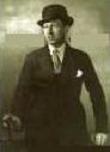 Sir
Francis Osbert Sacheverell Sitwell, 5th Baronet (1892- 1969) in his book Escape
with Me - an Oriental Sketch Book (1941), has
written: Sir
Francis Osbert Sacheverell Sitwell, 5th Baronet (1892- 1969) in his book Escape
with Me - an Oriental Sketch Book (1941), has
written:
"Let
it be said immediately that Angkor, as it stands, ranks as chief wonder of the
world to-day, one of the summits to which human genius has aspired in stone,
infinitely more impressive, lovely and, as well, romantic, than anything that
can be seen in China...
The material remains of a civilization that flashed its
wings, of the utmost brilliance, for six centuries, and then perished so utterly
that even his name has died on the lips of man." 'the neighboring Bayon can
be said to be the most imaginative and singular in the world, more lovely than
Angkor Vat, because more unearthly in its conception, a temple from a city in
some other distant planet...imbued with the same elusive beauty that often lives
between the lines of a great poem."
Round the great temple of Angkor Vat
is a vast area of mighty ruins with artificial lakes and pools, and canals and
bridges over them, and a great gate dominated by ' a vast sculptured head, a
lovely, smiling but enigmatic Cambodian face, though one raised to the power and
beauty of a god.' The face with its strangely fascinating and disturbing smile -
the 'Angkor smile' is repeated again and again.
(source: The
Discovery
of India - By Jawaharlal Nehru p. 208-209).
Robert
Joseph Casey
(1890 - 1962)
a reporter with Chicago Daily News, writing in his book
Four
faces of Shiva in 1926 wrote:
"Angkor
vat, supreme architectural effort of this culture, not only the most grandiose
temple of the group but probably the most stupendous undertaking attempted by
man since the corner-stone was laid for the tower of Babel."
Here
at Angkor was the finest metropolis in Asia – a town whose splendor is
permanently embossed in temple wall and tower and terrace. The people were
called the Khmer and were either of Hindu extraction or
the diligent pupils of Hindu teachers. There is mention of a kingdom
under Hindu direction, if not domination, in Indo-China as early as the year 238
AD and there is evidence that the Khmer flourished during the 13th
and possibly into the 14th century."
(source: Four
faces of Shiva - By Robert J Casey p. 31 - 32).
 Amaury
de Riencourt (1918 - ) was born in Orleans, France. He is
author of several books including The
American empire and The Eye of Shiva
and The Soul of India has written: Amaury
de Riencourt (1918 - ) was born in Orleans, France. He is
author of several books including The
American empire and The Eye of Shiva
and The Soul of India has written:
"Art
flourished in Kamboja as never before, centered around a capital city known to
all Asia as Angkor, the Magnificent, a city of more than a million inhabitants -
which when it was extricated from the jungle in modern times, contained not a
single human being.
Chinese and Indian envoys could hardly believe their eyes
when they gazed at the splendid temple of Angkor Vat, a
sublime work of art that was inspired by India but shaped by the
genius of Khmer people."
"Indian
inspiration provided the religion and the philosophy, the artistic forms and the
technique with which Angkor was built."
(source: The
Soul of India - By
Amaury de Riencourt ISBN 0907855032 p. 160-161).
Jeannine
Auboyer ( ? ) was the curator of the Musee
Guimet, Paris, and author of The Oriental World has
said:
"Its
splendid plan, the balance of its proportions, the elegance of its pillared
cloisters and the beauty of its decoration make it one of the masterpieces of
world architecture."
(source: The
Oriental World - By Jeannine Auboyer
Landmarks of World's Art quoted from Appendix page).
Sir H G Rawlinson (1880
- ) the great historian has observed:
“Had the Khmers left but this
single monument, it would have placed them among the great artists of the world,
so perfect is its architecture and so rare its art.”
 Ramesh
C Majumdar (1888-1980) eminent Indian historian, who points out
that from a very remote past, the Indians possessed a vague idea of the
countries in the Far East. Fabulous wealth earned by trade gave rise to stories
of Suvarnabhumi or Golden Land. Ramesh
C Majumdar (1888-1980) eminent Indian historian, who points out
that from a very remote past, the Indians possessed a vague idea of the
countries in the Far East. Fabulous wealth earned by trade gave rise to stories
of Suvarnabhumi or Golden Land.
“The Indian colonies in the Far East must ever remain as
the high watermark of maritime and colonial enterprise of ancient Indians”
“In the domain of art, Kambuja towers head and shoulders
above the rest. A general view of the city of Angkor Thom and of the monuments
round about it creates a solemn impression of dazzling brilliance which does not
suffer in diminution on a closer examination of the remains. Indeed
it may be said with perfect truth, that no other equal space on earth can show
anything comparable to Angkor monuments in massive grandeur…The Angkor wat is
justly regarded as the grandest of the monuments in Kambuja.”
"If
art is an expression of national character and a fair index of the culture and
civilization of a people, Kambuja easily takes the leading position among the
Indian colonies in Indo-China and constitutes an important landmark and the
greatest living testimony to the splendor of the civilization of which it is a
product."
(source: Ancient
India - By V D Mahajan p. 752 - 769 and Greater
India - By Arun Bhattacharjee p. 120).
 George Coedes
(1886 -
1969) former Director of L'Ecole Francaise d'Extreme
Orient, who had spent thirty-five years in French Indochina, eminent French scholar, author of
The Indianized States of Southeast Asia. He
has found that the story of India’s expansion is woven into the cultures of
Southeast Asia. “I am convinced that such research will reveal numerous
facts which will indicate a much deeper
Indianization of the mass of the population than the sociologists will at
present admit.” George Coedes
(1886 -
1969) former Director of L'Ecole Francaise d'Extreme
Orient, who had spent thirty-five years in French Indochina, eminent French scholar, author of
The Indianized States of Southeast Asia. He
has found that the story of India’s expansion is woven into the cultures of
Southeast Asia. “I am convinced that such research will reveal numerous
facts which will indicate a much deeper
Indianization of the mass of the population than the sociologists will at
present admit.”
He has written:
"Any attempt to understand the
culture of Southeast Asia, and Cambodia in particular, must take account of
Indian influence. "
India’s civilizing influence beyond the Ganges “is one of
the outstanding events in the history of the world.” Although the peak of her
influence was over by 1500, India’s heritage permeates the art, law,
literature, religion, and politics of present day Southeast Asia. It is with
justifiable pride that Indian scholars refer to the history of Southeast Asia as
the history of “Greater India.” The geographic area called “Father India” consists of
Indonesia, or island of Southeast Asia and the Indochinese Peninsula, or India
beyond the Ganges, including the Malay Peninsula. Around the beginning of the
Common Era, Southeast Asia was the “land of gold” toward which the Indian
navigators sailed…”
Culturally speaking, Farther India today is characterized by
more or less deep traces of Indianization that occurred long ago:
the importance of the Sanskrit element in the vocabulary of the languages
spoken there; the Indian origin of the alphabets with which those languages have
been or still are written; the influence of Indian law and administrative
organization; the persistence of certain Brahmanic traditions in the countries
converted to Islam as well as those converted to Singhalese Buddhism; and the
presence of ancient monuments which, in architecture and sculpture, are
associated with the arts of India and bear inscriptions in Sanskrit.
The history of the expansion of
Indian civilization to the east has not yet been told in its entirety.
The relations between India proper and Farther India
date back to prehistoric times. But from a certain period on, these
relations resulted in the founding of Indian kingdoms on the Indochina Peninsula
and in the islands of Indonesia. The oldest archaeological remains these states
have left us are not necessarily evidence of the first civilizing wave. It is
probable a priori, that the priests who consecrated the first Brahmanic or
Buddhist sanctuaries and the scholars who composed the first Sanskrit
inscriptions were preceded by seamen, traders, or immigrants – founders of
first Indian settlements. These settlements, in turn, were not always entirely
new creations; in many cases (Oc Eo in Cochin China, Kuala Selingsing in Perak,
sempaga in Celebes etc). they were built on Neolithic sites that the seamen from
India had frequented perhaps from time immemorial.
Indianization must be understood
essentially as the expansion of an organized culture that was founded upon the
Indian conception of royalty, was characterized by Hindu or Buddhist ideas, the
mythology of the Puranas, and the observance of the Dharmasastras, and expressed
itself in the Sanskrit language. "
"A study of ancient India, viewed from the East, which
has scarcely begun, seems to promise rich results."
(source: The spread of Indian culture in
Southeast Asia
- By George Coedes p. 98 - 99 and The Indianized States of Southeast
Asia
- By George Coedes p. xv – xvii and p. 14).
 Helen
Churchill Hungerford Candee (1859
-1949)
who was a noted author and lecturer on the arts and travel and survivor of the
Titanic and author of Angkor
the Magnificent, must
have been standing on this terrace almost 70 years ago when she wrote: Helen
Churchill Hungerford Candee (1859
-1949)
who was a noted author and lecturer on the arts and travel and survivor of the
Titanic and author of Angkor
the Magnificent, must
have been standing on this terrace almost 70 years ago when she wrote:
"Away
from the plateau of entry the causeway stretched over the moat, a veritable
avenue to the temple walls. It is balustraded with Nagas on either side, it is
36 feet wide, and its length is the unbelievable width of the moat, over two
hundred meters, nearly 700 feet. A moat for us means a grassy cincture sunk
around a castle. The moat of Angkor vat has no such
niggard measure. It is a lake in width, it is enclosed in masonry, and it
measures about three miles around! Superb!
"Few architects think in measurements
as big as that."
“Any
architect would thrill at the harmony of the facade, an unbroken stretch of
repeated pillars leading from the far angles of the structure to the central
opening, which is dominated, by three imposing towers with broken summits.”
"The
Vat rises in fair majesty against the heavens. "
"All the ancient power
of the temple and its gods is puissant still. It surrounds those who look upon
the wonder. The eyes sweep upwards over the rising storeys, up, up, to the
mounting towers, to the pure firmament, and pause subdued. It
is ever thus. Some power overcomes, some mysterious spell is caste, one never
look upon the ensemble of the Vat without a thrill, a pause, a feeling of being
caught up into the heavens. Perhaps it is the most impressive sight in the world
of edifices. The
whole place is covered, once you open your eyes to it, columns, lintels,
surbases, panels, pediments, jambs of doors and windows.
One says that this holy sanctuary contained a wondorus statue of God
Vishnu carved from precious stone. "
"The
portico is magnificent in a way not unfamiliar. One is at once in harmony with
the plan. Nothing exotic about it, nothing that shocks Western traditions,
simply grandeur and dignified beauty as we know it in our own
architecture."
(source: Angkor
the Magnificent
- By Helen Churchill Candee p. 65 - 90).
 Will
Durant (1885-1981) American historian, would like the West to
learn from India, tolerance and gentleness and love for all living things: Will
Durant (1885-1981) American historian, would like the West to
learn from India, tolerance and gentleness and love for all living things:
“Angkor wat is a masterpiece equal to the finest
architectural achievements of the Egyptians, the Greeks, or the cathedral
builders of Europe. An enormous moat, twelve miles in length, surrounds the
temple; over the moat runs a paved bridge guarded by dissuasive Nagas in stone;
then an ornate enclosing wall; then spacious galleries, whose reliefs tell again
the tales of the Mahabharata and the Ramayana; then the stately edifice itself,
rising upon a broad base, by level after level of a terraced pyramid, to the
sanctuary of the God, two hundred feet high. Here
magnitude does not detract from beauty, but helps it to an imposing magnificence
that startles the Western mind into some weak realization of the ancient
grandeur once possessed by Oriental civilization."
"Indian art had accompanied
Indian religion across straits and frontiers into Sri Lanka, Java, Cambodia,
Siam, Burma, Tibet, Khotan, Turkestan, Mongolia, China, Korea and Japan; “in
Asia all roads lead from India.”
(source: Story
of Civilization: Our Oriental Heritage - By Will
Durant MJF Books. 1935. p. 605).
Lonely
Planet travel guide gives this description of Angkor wat:
“Angkor
Wat, with its soaring towers and extraordinary bas-reliefs, is considered by
many to be one of the most inspired and spectacular monuments ever conceived by
the human mind. It was built by King Suryavarman II reigned 1112-52) to
honour God Vishnu...

Magnificent
statue of Lord
Vishnu - located in the entrance of Angkor wat.
Lord Vishnu, considered the preserver of the Cosmos
in the Hindu Trinity, characteristically stands upright and balanced. As the
preserver, Vishnu embodies compassion, which is considered the self-existent,
pervasive power maintaining the universe and cosmic order (Dharma). Vishnu holds
his attributes, the discus and conch.
King Suryavarman II
(reigned from 1113 - 1150 AD) dedicated the temple to Lord Vishnu.
On his death the great king took the posthumous name Paramavishnulok (he who has
gone to the paradise of the supreme Vishnu).
(image
source: webmaster's own collection of photos taken during
a recent visit).
***
The
central temple complex consists of three storeys, each of which encloses a
square surrounded by intricately interlinked galleries. Rising 31m [102 feet]
above the third level and 55m above the ground is the central tower, which gives
the whole ensemble its sublime unity. The temple is surrounded by a vast moat,
which forms a rectangle 1.5km by 1.3km.... “
 Han
Suyin (1917 - ) is a prominent writer on
modern Chinese and Asian subjects. Author of several books including A
Many-splendoured Thing. Han
Suyin (1917 - ) is a prominent writer on
modern Chinese and Asian subjects. Author of several books including A
Many-splendoured Thing.
She
has observed:
“No
film, no photograph, nothing can prepare one for Angkor and its impact. It is
even difficult to speak of it in other than superlative terms. For it is
colossal, enormous, prodigious, startling, awesome…”
"But
what formidable, what enormous, what impossibly incomparable monuments!
Testimony to the greatness and beauty, the vast wealth and strength of the
Angkorean civilization, which lasted for some five centuries.
"And
along the galleries, hundreds of yards long, are the scenes from the great
Indian epics, the Ramayana and the Mahabharata. There is a superb Vishnu
Churning of the Sea of Milk to gain the elixir of life: a great serpent coils
itself around a mountain, and the gods and demons pull and spin the mountain to
churn the sea, and all sorts of wonderful things come of the sea, all the
creatures of the world, including Vishnu's wife Lakshmo, born of the sea
spray....there are so many sculptures that each stone on the outside is covered
with carvings; some are delicate as lace, others are monumental. "
(source: Ancient
Cambodia - By Donatella Mazzeo and Chiara Antonini - Foreward
p. 6 - 8).
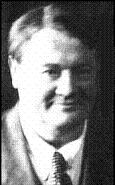 Lord
Alfred Harmsworth Northcliffe (1865 - 1922) remarked when he went
to Cambodia as a reporter for his newspaper, Lord
Alfred Harmsworth Northcliffe (1865 - 1922) remarked when he went
to Cambodia as a reporter for his newspaper,
“No
Sultan’, he cabled, ‘no Mikado, No Viceroy of India could offer his guests a
comparable spectacle.”
(source:
The
Road to Angkor - By Christopher Pym
p. 176 - 180). For more
refer to Glimpses XIX.
K M Srivastava (1927 -
) who has served for 33 years with the Archaeological Survey of India,
and has conducted several excavations at many important sites in India. In 1982
he led a nine member team to Kampuchea to prepare a project report on the
preservation of the temple of Angkor Wat.
“The Hindu culture was
deeply rooted in the soil of Kambuja as is evident from the perfect Sanskrit
kavya style used in the inscriptions at Mebon and Pre-Rup which clearly
indicates that their authors possessed deep knowledge of all the metres. They
were also acquainted with Sanskrit rhetoric and prosody. An adequate knowledge
of the Indian epic, Kavyas Puranas and other literature was also possessed by
them. Indian philosophical theories and spiritual conceptions, besides religious
and mythological beliefs of various sects in India were very well known to them.
They were well versed in the grammatical treatise of Panini. Four verses of Pre-Rup,
inscription allude without any doubt to Kalidasa’s
Raghuvamsa, sometimes repeating the words used by the great poet. “
(source:
Angkor Wat and cultural ties with India - By K M Srivastava
p. 25).
 Helen
Ibbitson Jessup (? ) author of Sculpture
of Angkor and Ancient Cambodia: Millennium of Glory captures to
near perfection the overwhelming sensation of awe and
mystery that Angkor – among the greatest, and the most ambitious, of
architectural monuments in the world – produces in the heart of even the most
hardened, or casual, visitor. For the site,
with its sprawling, seemingly endless, expanse and decay does not sum up the
past of Cambodia alone, but, in some ways, of mankind itself. The
majestic site: miles of ‘gallery and tower’, ancient
temples soaring heavenwards and crumbling at the same time, monuments to man’s
faith and energy, stone and root and dust. Helen
Ibbitson Jessup (? ) author of Sculpture
of Angkor and Ancient Cambodia: Millennium of Glory captures to
near perfection the overwhelming sensation of awe and
mystery that Angkor – among the greatest, and the most ambitious, of
architectural monuments in the world – produces in the heart of even the most
hardened, or casual, visitor. For the site,
with its sprawling, seemingly endless, expanse and decay does not sum up the
past of Cambodia alone, but, in some ways, of mankind itself. The
majestic site: miles of ‘gallery and tower’, ancient
temples soaring heavenwards and crumbling at the same time, monuments to man’s
faith and energy, stone and root and dust.
(source: Angkor:
The curling roots of time - tribuneindia.com).
Dr. H G (Horace Geoffrey) Quaritch
Wales (1900 - ) author
of The Making of Greater India: A Study in
South-East Asian Culture Change and Towards
Angkor in the footsteps of the Indian invaders. Lecturer in Thailand
from 1936 - 48). He was a great lover of Indian civilization, and expert
upon it, who yet writes of Cambodian art, and of the Hindu influence upon it, in
these very just terms:
“When the guiding hand of India
was removed, her inspiration was not forgotten, but the Khmer genius was
released to mould from it vast new conceptions of amazing vitality different
from, and hence not properly to be compared with, anything matured in a purely
Indian environment…It is true that Khmer culture is
essentially based on the inspiration of India, without which the Khmers at best
might have produced nothing greater than the barbaric splendor of the Central
American Mayas; but at the same time it must be admitted that here, more than
anywhere else in Greater India, this inspiration fell on fertile soil.”
(source: Escape with me – By Sir
Osbert Sitwell p. 82 – 83).
Refer to chapter on Seafaring
in Ancient India, War in
Ancient India and India
on Pacific Waves?
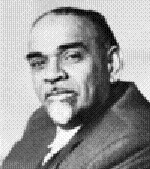 Sardar
Kavalam Madhava Panikkar (1896-1963) Indian historian, in his
book A Survey of Indian
History, was the
most impressive in depicting how South India’s expansion into “further
India” was achieved by the very sea power that ten centuries later was to open
India to colonization by the West: Sardar
Kavalam Madhava Panikkar (1896-1963) Indian historian, in his
book A Survey of Indian
History, was the
most impressive in depicting how South India’s expansion into “further
India” was achieved by the very sea power that ten centuries later was to open
India to colonization by the West:
“At the end of the fifth century the area of the Mekong
valley, Malaya and the Indonesian islands were dotted with Hindu principalities
some of which, like the kingdom of Funan, had attained considerable importance
and prosperity. This was the formative period. Hindu culture and organization
had been established on a firm basis, and the local population – at least the
higher strata – assimilated with the Indian emigrants and colonists. The next
five centuries witness a great flowering of Indian culture in these areas which
properly belong to Indian history, because at least till the twelfth century,
these people considered themselves as integrally belonging to the Indian
world.”
"The
early inscriptions are in classical Sanskrit, full of allusions to ancient
India..."Kambuja was ardently Hindu till the middle of the seventh century
when Buddhism is first alluded to. The two religions co-existed as in India,
though till the very end Hinduism continued predominant."
(source: Under Western Eyes - By Balachandra
Rajan p. 37 – 38 and A Survey of Indian
History - By K M Panikkar p. 94).
 Rabindranath
Tagore (1861-1941) poet, author,
philosopher, Nobel prize laureate. Tagore
was deeply critical of the British Raj in India. Rabindranath
Tagore (1861-1941) poet, author,
philosopher, Nobel prize laureate. Tagore
was deeply critical of the British Raj in India.
He
has remarked:
“To
know my country in truth he wrote in 1934, one has to travel to that age when he
realized her soul and thus transcended her physical boundaries; when she
revealed her being in a radiant magnanimity which illumined the Eastern
horizon."
(source:
The Journal of the Greater India Society - Preface
By Rabindranath Tagore vol 1, 1934).
Benjamin
Rowland ( - 1972) Curator of American Art and
author of The
Art and Architecture of India
"Perhaps
it might be compared’, ‘to the impression that would be produced on a
wanderer in another millennium coming suddenly upon the ruins of Manhattan
rising silent and empty above the Hudson."
(source:
The Art and Architecture of India - By Benjamin Rowland
and The
Road to Angkor - By Christopher Pym
p. 176 - 180).
Wim
Swaan ( ? ) author of The Lost Cities of Asia has
observed:
"Gupta India is in its heyday could well claim to be the
best governed and most civilized country in the world. Such was the culture and
the extraordinarily rich and complex body of religion and philosophy which
Indian traders and missionaries carried throughout ‘Greater India’. To these
lands she brought also her knowledge in irrigation, husbandry and metallurgy,
mathematics and astronomy, a literary language and an alphabet. Significantly,
the cultural dominance of India was achieved not through force but by the
voluntary acceptance of her manifestly superior gifts on the part of eager and
apt pupils. This was in marked contrast to the southward march of China, an
armed expansion on the regular Roman model.
A fascinating question, and one which has had a far-reaching
effect on world history, is why China –
particularly in the case of Indo-China – did not exercise a dominant influence
during these early years. Chinese ships and navigation methods were both greatly
inferior. Long after Indian ships were able to strike out boldly across the open
seas, Chinese ships were still forced to hug the shore, and this made them all
the more vulnerable to the attacks of the numerous pirates that infested the
waters off her southernmost provinces. The zenith of Indian power during the
Gupta Period coincided with the most unsettled period in Chinese history.
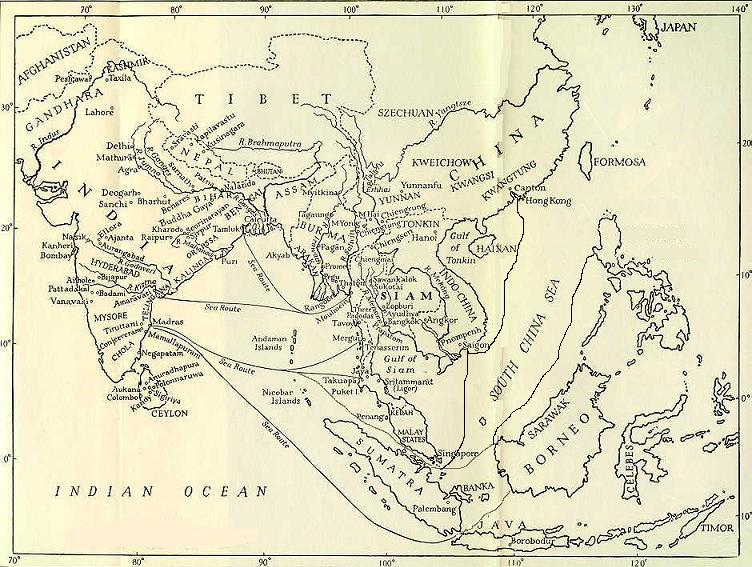
India
was the spark that fired the blaze.
Map showing
relations and Sea routes between India and Greater India. Long
after Indian ships were able to strike out boldly across the open seas, Chinese
ships were still forced to hug the shores.
"The
whole of Asia was to remain forever heavily in debt to India."
(image
source: A
Survey of Indian History - By Sardar
Kavalam Madhava Panikkar).
***
Louis De La Haba ( ? )
in the
book Splendors of the Past: Lost Cities of the Ancient World wrote:
“This was the time of the great
Indian expansion, when seafaring merchants fanned out across the Indian Ocean
and brought to Southeast Asia a seething ferment of new ideas. From Burma to
Indonesia, they established a chain of settlements along the coasts from which
they traded for gold, precious stones, perfumes, and spices. The merchants
brought with them their religions, Hinduism and then Buddhism; their literary
language, Sanskrit, their art and technology; their science and mathematics.
It would be difficult to overestimate the influence India
brought to bear on the native cultures of Southeast Asia and on the
civilizations that evolved there over the next millennium."
(source: Splendors
of the Past: Lost Cities of the Ancient World
- National Geographic Society p. 184 - 190).
 Heinrich
Zimmer (1890-1943) the great German
Indologist, in the noblest of
many books, in his book, Asia before Europe: Economy
and Civilization of the Indian Ocean from the Rise of Islam to 1750,
writes of the Indian cultural world: Heinrich
Zimmer (1890-1943) the great German
Indologist, in the noblest of
many books, in his book, Asia before Europe: Economy
and Civilization of the Indian Ocean from the Rise of Islam to 1750,
writes of the Indian cultural world:
“Each of the colonial cultures and art styles of Ceylon,
Indonesia, and Further India, as well as that of Tibet, China, Korea and Japan,
took over in a worthy way the Indian heritage, giving to it an original and
happy local application. Out of various ethnological and biological requirements
self-contained styles were formed that were the peers in originality, nobility
and delicacy of the Indian.”
India remains “the creative
hearth”: Indeed, whenever the incredible brightness of the spiritual, the
balanced repose of the dynamic, or the brilliant power of the triumphantly
omnipotent are made effectively manifestation in Oriental art, an Indian model
is not far to seek.”
(source: Under Western Eyes
- By Balachandra Rajan p. 37 – 38). Recently
an Ancient
statue of Lord Vishnu
has been found in Russian town of the
Volga region.
For
more on The Glorious Hindu Legacy: Indic influence in Southeast Asia refer to
the chapters Suvarnabhumi
and Glimpses
XII to Glimpses
XIX.
 Dr.
Ananda Kentish Cooraswamy (1877-1947) the
late curator of Indian art at the Boston Museum of Fine Arts, was unexcelled in
his knowledge of the art of the Orient, and unmatched in his understanding of
Indian culture, language, religion and philosophy. Dr.
Ananda Kentish Cooraswamy (1877-1947) the
late curator of Indian art at the Boston Museum of Fine Arts, was unexcelled in
his knowledge of the art of the Orient, and unmatched in his understanding of
Indian culture, language, religion and philosophy.
He so aptly put it: “although
Far-Eastern races developed independently elements of culture no less important
than those of India – almost all that belongs to the common spiritual
consciousness of Asia, the ambient in which its diversities are reconcilable,
is of Indian origin.”
Indeed, the whole of Asia was to
remain forever heavily in debt to India."
(source: Lost Cities of Asia - By Wim Swaan
p. 13 - 16).
Geoffrey
Gorer (1904 - ?) British anthropologist and author of Bali
and Angkor, a trenchant critic of Khmer architecture, found much that
is worthy of high praise at Angkor Wat:
"...Angkor
Wat is the most perfect building in Angkor, and one of the loveliest pieces of
architecture in the world...it makes it almost unique in the big buildings of
the world. Space is treated as a constituent part of the whole."
 Remarking
to Andre
Malraux (1901-1976) author of Anti-memoir,
profound thinker and French prolific writer, about the Apsaras at
Angkor, he remarked: Remarking
to Andre
Malraux (1901-1976) author of Anti-memoir,
profound thinker and French prolific writer, about the Apsaras at
Angkor, he remarked:
"to me the
Apsaras are Grace personified, the highest expression of femininity ever
conceived by the human mind."
(source: Angkor:
The Hidden Glories - By Michael Freeman and Roger Warner p. 182
- 190).
Footprint handbook on Cambodia
has said:
"Angkor architecture is remarkable both for its majestic scale
and its intimate and intricate details.
Angkor wat has been described as the largest religious
monument in the world. The first glimpse of its five heaven wards soaring towers
cannot fail to stir the soul and quicken the pulse.
Angkor wat is an architectural allegory, depicting in stone
the epic ales of Hindu mythology. The temples greatest sculptural treasure is
its 2 meters high bas reliefs, around the walls of the outer gallery. It is the
longest continuous bas reliefs in the world. In some areas traces of paint and
gilt that once covered the carvings can still be seen. The bas reliefs narrate
stories from the Ramayana and Mahabharata, as well as legends of Lord Vishnu,
and are reminiscent of Pallava and Chola art in Southeast India.
The Angkor period encapsulated
the greatest and best of Cambodia's art and architecture. Much of it shows
strong Indian influence."
(source: Cambodia - By Footprint handbook).
 Dr.
Nandita Krishna ( ? ) Director, C.P.R.
Ayar Environmental Education Centre, India has written: Dr.
Nandita Krishna ( ? ) Director, C.P.R.
Ayar Environmental Education Centre, India has written:
“It
is a pity India has forgotten the Angkors. A
visit to Siem Reap is essential to understand Hinduism and to appreciate Indian
art. There is a visible happiness in the deities that
is rare in the more withdrawn imagery of India.
The temples are mysterious and
haunting as they brood over the dark jungle, guarding secrets of an ancient
people lost in time. The tall pyramids of Meru give the impression of sanctums
reaching the skies. While the rest of the world has rushed to
save the monuments, we have taken a tentative step to restore Ta Prohm
(“grandfather Brahma”) temple."
(source:
The
Temples of Angkor - By Nandita Krishna).
Malcolm Macdonald ( ? ) author
of the book, Angkor has remarked:
"Angkor vat is the supreme masterpiece of Khmer art.
Built in the first half of the 12th century, it is an Asian
contemporary of Notre dame de Paris and Chartres Cathedral in France, and of Ely
and Lincoln cathedral in England. But in spaciousness
and splendor it is more ambitious than any of these. It is said to be the
largest religious building ever constructed by man.
One can best gain an impression of its size and plan by
viewing it from the air. The measurements of the place are impressive. Each of
the four sides of the moat, which forms an almost exact square, is about a mile
in length. The outer and inner enclosures are huge open spaces to accommodate
congregations of many thousands of people. Even the walls of the central
sanctuary measure more than half a mile in circumference, and the pile is
massive not only in length and width, but also in height. A pyramid temple, it
climbs in three successive stages to its central cluster of five towers, the
topmost of them rising two hundred and fifteen feet about the surrounding
forest. Each tower is crowned with a soaring pinnacle
shaped like a bursting lotus bud. That was the vision which took Henri
Mouhot’s breath away, when he came upon it suddenly amongst the jungle trees.
Fortunately Angkor vat is not only the finest but also one of
the best-preserved of Khmer monuments. It was built
with superb, enduring strength. It has handsome, masculine grace. It combines a
glorious mixture of qualities. It sprawls spaciously, and yet its overall
proportions are perfect; there is a suggestion of austerity about its simple,
massive design, but the details of its decoration are in places riotously
lovely; and the contrast between its wide, smooth, grassy enclosures and its
acres of sculptured masonry is almost theatrical. The galleries, stairways,
libraries and shrines in its courtyards are palatial, and they stand solidly. No
building on earth seems more sure of itself.
Angkor vat’s glory should abide
unspoilt as long as any scrap of evidence of human civilization lasts on the
planet Earth."
(source: Angkor
- By Malcolm Macdonald p. 101 - 108).
 Philip
Rawson ( ? ) academic, artist, Keeper of the Gulbenkian Museum of Oriental Art and
archaeology at the University of Durham and author of The Art of Southeast Asia has
written: Philip
Rawson ( ? ) academic, artist, Keeper of the Gulbenkian Museum of Oriental Art and
archaeology at the University of Durham and author of The Art of Southeast Asia has
written:
“The
culture of India has been one of the world’s most powerful civilizing forces.
Countries of the Far East, including China, Korea, Japan, Tibet and Mongolia owe
much of what is best in their own culture to the inspiration of ideas imported
from India. The West, too has its own debts. But the members of that
circle of civilizations beyond Burma scattered around the Gulf of Siam and the
Java Sea, virtually owe their very existence to the creative influences of
Indian ideas. No conquest or invasion, no forced conversion imposed upon them.
They were adopted because the people saw they were good and that they could use
them. “
“The
sculptures of Indian icons produced in Cambodia during the 6th to the
8th centuries A.D. are masterpieces, monumental, subtle, highly
sophisticated, mature in style and unrivalled for sheer beauty….”
“One
of the most interesting pieces of all is a fragmentary bronze bust, from the
western Mebon, of the God Vishnu
lying asleep on the ocean of non-being. Head and shoulders and the two right
arms survive. It shows the extraordinary, delicate integrity and subtle total
convexity of surface, which these sculptors could achieve by modeling. Eyebrows,
moustache and eyes seem to have been inlaid, perhaps with gold, silver or
precious tone, though the inlay is gone and only the sockets remain. This
was one of the world’s great sculptures. "
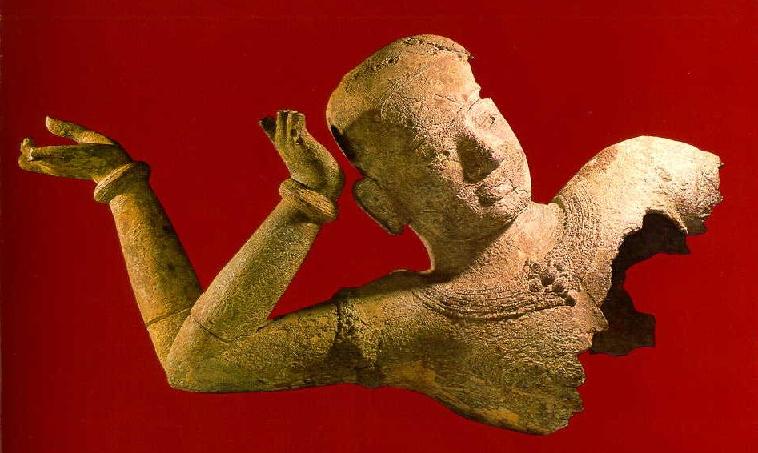
Lord Vishnu:
Lying on his couch, the serpent Ananta (without end) alludes to the story
of the creation of the world.
“One
of the most interesting pieces of all is a fragmentary bronze bust, from the
western Mebon, of the God Vishnu
lying asleep on the ocean of non-being. The bust is 6 1/2 foot wide. It is the
largest antique bronze sculpture discovered so far from Cambodia.
This
was one of the world’s great sculptures.
Most
of the elegant bronze statues in the temples have all but disappeared, except
portion of this huge statue of Lord Vishnu. It testifies to the excellent
workmanship of the Khmer. The smaller statues and ornaments found reveal a high
level of technical and artistic skill. They were made by the lost wax technique
and some parts were often cast separately and then riveted together. Some were
decorated with precious metals. Sadly none of the articles made of gold, silver
or alloys of precious metals referred to in the Khmer inscriptions, known as
samrit, have survived, apart from the magnificent Nandi, the bull ridden by Lord
Shiva.
(image
source: The
Art of Southeast Asia - By Philip
Rawson).
***
Another
magnificent bronze of Shiva,
from Por Loboeuk, suggests the wealth of metal art that once must have existed
in Cambodia (Kamboja) at the height of its power."
"The
genius of the artists of that age was for relief. Indeed one might say that Angkor
Wat is a repertory of some of the most magnificent relief art
that the world has ever seen. The open colonnaded gallery on the first storey
contains over a mile of such works, six feet high. The main sources for
the relief subject matter are the Mahabharata
and Ramayana,
as well as legends of Vishnu and his incarnation Krishna.
The wars of classical legend, in which incarnations of the various persons of
the Hindu deity triumph at length over demonic adversaries. The artists’ skill
is everywhere apparent."
(source: The
Art of Southeast Asia - By Philip
Rawson p. 1 - 77. For more refer to chapter on Suvarnabhumi,
Seafaring
in Ancient India, War in
Ancient India and India
on Pacific Waves?
 Earl
A. Powell III ( ? ) Director, National Gallery of
Art, Washington, D.C. Earl
A. Powell III ( ? ) Director, National Gallery of
Art, Washington, D.C.
"Angkor
is utterly transforming. The jungle and the ruins intertwine in beautiful and
mysterious harmony. Sunset from the top of Angkor Wat has to be one of the most
extraordinary experiences any traveler could possibly have."
P.
Jennerat de Beerski ( ? ) author of Angkor, Ruins in Cambodia has
remarked:
"Go
to Angkor, my friend, to its ruins and to its dreams."
(source: Angkor
Ruins in Cambodia - By P. Jennerat de Beerski
Boston
& New York: 1924 Houghton Mifflin p.20).
Donatella Mazzeo (
? ) author of Ancient Cambodia has remarked:
"In an imaginary history of the masterpiece created by human
genius through the centuries, Angkor wat would certainly be given its place as
the supreme work of the “classical” period of the Khmer civilization. In
fact, this is the monument that most effectively sums up the artistic,
technical, and spiritual experiences of this people, and then expresses all this
most creatively and thoroughly.
Angkor wat stands as a mature classic. It is perhaps in its
bas-reliefs that Angkor wat attains its pinnacle of artistry, and these made use
of mythological, epic, or historical scenes for their subject matter. We meet
these bas-reliefs in the galleries around the perimeter of the first level of
the temple-mountain. "
(source: Ancient
Cambodia - By Donatella Mazzeo and Chiara Antonini
p. 100 - 106).
 Jawaharlal
Nehru (1889-1964) first prime minister of
free India, was more than a deeply moral human being. He yearned for spiritual
light. He was particularly drawn to Swami Vivekananda and the Sri Ramakrishna
Ashram. The Upanishads fascinated him. Jawaharlal
Nehru (1889-1964) first prime minister of
free India, was more than a deeply moral human being. He yearned for spiritual
light. He was particularly drawn to Swami Vivekananda and the Sri Ramakrishna
Ashram. The Upanishads fascinated him.
He
writes:
“In
Cambodia the mighty remains of Angkor the only artistic influence that has been
so far detected came from India. But Indian art was flexible and adaptable and
in each country it flowered afresh and in many new ways, always retaining that
basic impress which it derived from India. The capital became famous in Asia and
was known as ‘Angkor the Magnificent’, a city of a million inhabitants,
larger and more splendid than the Rome of the Caesars.”
(source: The
Discovery of India - By Jawaharlal Nehru
Oxford University Press. 1995 p. 204 – 205).
David P Chandler (
? ) author
of A History of Cambodia writes:
“The close fit of these spatial relationships to notions of
cosmic time, and the extraordinary accuracy and symmetry of all the measurements
of Angkor, combine to confirm the notion that the temple was, in fact, a coded
religious text that could be read by experts moving along its walkways from one
dimension to the next. “
Rudolph
Wurlitzer ( ? ) screenwriter, novelist and
author of Hard Travel to Sacred Places has
observed:
"We stumble around the massive solemnity of this temple
mountain, which offers not so much solace or refuge as it does awe and even a
shiver of atavistic fear at the omniscience of its precision. It is a place of
power, once ruled by Hindu devarajas, under whose totality religious art and
sculpture reflect Shiva and Vishnu…."
"One huge bas relief in particular
stuns us with its fluid elegance in depicting the Hindu creation myth,
“churning the sea of milk” In a union between gods and demons, the giant
serpent Vasuki is pulled back and forth between the monkey god, Hanuman, and a
line of demons. Vasuki who has wrapped himself around Mount Mandara, is
supported by a giant turtle in the Sea of Milk, the ocean of immortality. As
Vishnu overseas this divine rhythm of opposites, the gods and demons rotate the
mountain and churn the sea into foam, releasing a seminal fluid which creates a
divine ambrorsia, or amrita, the essence of elixir of life. Much of the bas
relief has faded from centuries of worshippers rubbing their hands over the
figures, but overall it is still exquisitely defined.
Angkor wat has overpowered as much as inspired me. It is as
if I’ve trapped myself my wishing for relief, for a transcendent moment, or
even, on a more banal level, a catalyst that would revive our sagging energies.
The magnificence of the sheer mass of Angkor Wat, the weight and abundance of
imagery, has become oppressive. I am disoriented by so much visual grandeur."
(source: Hard
Travel to Sacred Places – By Rudolph Wurlitzer p. 128 - 138).
 Maurice
Glaize (1886 -1964) was the conservator of Angkor from 1937 to 1945. In 1944 he
published a guide to the temples, entitled Les
Monuments du groupe Angkor (The Monuments of the Angkor Group), which
is still widely read and used by visitors to the temple, Maurice
Glaize (1886 -1964) was the conservator of Angkor from 1937 to 1945. In 1944 he
published a guide to the temples, entitled Les
Monuments du groupe Angkor (The Monuments of the Angkor Group), which
is still widely read and used by visitors to the temple,
"If Angkor Wat is the
largest and the best preserved of the monuments, it is also the most impressive
in the character of its grand architectural composition, being comparable to the
finest of architectural achievements anywhere." Angkor Wat is a work of
power and reason.
"attains
a classic perfection by the restrained monumentality of its finely balanced
elements and the precise arrangement of its proportions. It is a work of power,
unity and style."
(source:
Angkor
Wat
- psychecentral.com).
Arun Bhattacharjee (
? ) author
of Greater India has observed:
“This classic art of Kambuja is associated with Angkor and
shows the high-water-mark of its glory. In massive grandeur on other equal space
on earth cannot show anything comparable to Angkor monuments. The exquisite
temples of Angkor provide the main example of Khmer art that has been left to
us. Angkor ranked as a chief wonder of the world today – one of the summits to
which human genius has ever aspired in stone.”
The Angkor vat is not remarkable for architecture only. The
walls of the galleries are covered with continuous friezes of bas reliefs and
other sculptures. The scenes are largely drawn from the Indian epics and are
full of life and movements. The plastic art of Kambuja is revealed at its best
in the graceful and refined bas reliefs that decorate the long galleries. Thus
Angkor shows the vastness of dimensions and fineness of decoration. So the
artists of Kambuja conceived like giants and finished like jewelers.”
(source: Greater
India - By Arun Bhattacharjee p. 118 - 119).
For more refer to chapter on
Suvarnabhumi,
Seafaring
in Ancient India, War in
Ancient India and India
on Pacific Waves? and
Glimpses XIX.
 Arnold
Toynbee (1889-1975) the great British historian.
His massive research was published in 12 volumes between 1934 and 1961 as `A
Study of History'. Author of several books, including Christianity:
Among the Religions of the World and One
World and India. Arnold
Toynbee (1889-1975) the great British historian.
His massive research was published in 12 volumes between 1934 and 1961 as `A
Study of History'. Author of several books, including Christianity:
Among the Religions of the World and One
World and India.
"Angkor is not orchestral; it is monumental. It is
an epic poem which makes its effect, like the Odyssey and like Paradise Lost, by
the grandeur of its structure, as well as by the beauty of its details. Angkor
is an epic in rectangular forms imposed upon the Cambodian jungle."
(source: East to West:
a
journey round the world - By Arnold Toynbee
Publisher: New York, Oxford).
“India
is the central link in a chain of regional civilizations that extend from Japan
in the far north-east to Ireland in the far north-west. Between these two
extremities the chain sags down southwards in a festoon that dips below the
Equator in Indonesia. It is not of
course only in a geographical sense that India is in a key position. At the
present moment, for instance, it is widely recognized that India holds the
balance in the world-wide competition between rival ideologies."
(source:
Greater
India - By Arun Bhattacharjee -
Munshiram Manoharlal Publishers Private Limited, 1981, New Delhi p. 7).
Michael
Buckley ( ? )
Moon Handbooks
“Occupying an entire square
kilometer, Angkor Wat is the world’s largest temple and the best preserved of
all the Angkorian temples. This masterpiece of Khmer design is contemporary with
the major Gothic cathedrals of Europe. Angkor Wat’s central tower soars 65
meters, equivalent to Notre Dame Cathedral in Paris. Angkor Wat is estimated to
contain the same cubic volume of stone blocks as Egypt's pyramid of Cheops.
Every stone surface at Angkor is carefully dressed, carved, and
decorated.”
(source: Laos
and Angkorwat ceramic excursion).
 Vimla
Patil ( ? ) associated with Femina,
India’s number one women’s magazine, published for 29 years. Vimla
Patil ( ? ) associated with Femina,
India’s number one women’s magazine, published for 29 years.
She
has remarked:
"The
Angkor Wat temple is the biggest Hindu temple in the world. It is
counted among the seven modern wonders of the world and is a UNESCO World
Heritage Site visited by millions of tourists each year. Imagine that till 150
years ago, this whole city was undiscovered, being covered by thick jungles and
overgrown trees!
This temple is a wonderful example of
the Hindu concept of the cosmos. The moat represents the oceans. The temple is
the Mount Meru and the galleries, which lead up to the sanctum, are the various
continents. The constant upward movement of the building from one gallery to the
next represents the spiritual path of a human being. The final destination is
the sanctum sanctorum where he/she comes face to face with divinity."
(source:
A
Fascinating Page From History – Monuments of Angkor Wat - By Vimla Patil
-
South Asian Women's Forum).
King
Norodom Suramarit of Cambodia (1920 - 1960) in
a banquet in honor of Dr. S Radhakrishnan in
Cambodia in 1957 he said:
“We
are your spiritual descendants. A man called Kaundinya
(Brahmin) came from South India years ago, defeated the Cambodian princess,
married her, settled down, established his dynasty, and, we are the spiritual
descendants of that dynasty. The name Khmer civilization which you
give to that comes from the word Kh-Meru of which Kaundinya was a citizen
here."
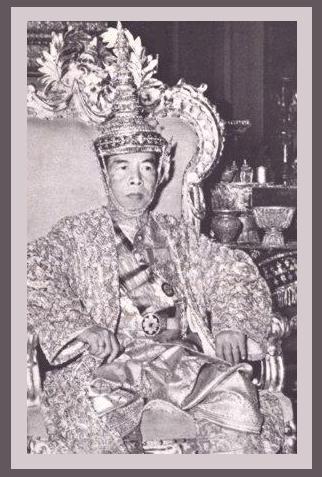
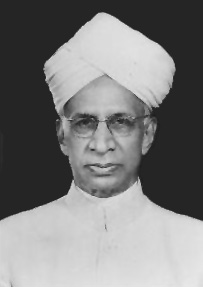
King
Norodom Suramarit of Cambodia (1920 - 1960)
and Dr. S Radhakrishnan (1888-1975) President of India.
In
a banquet in honor of Dr. S Radhakrishnan in
Cambodia in 1957 he said:
"We
are your spiritual descendants."
***
(source:
Our Heritage - By S Radhakrishnan p.
26).
 Michael Freeman (1972
- ) a noted photographer has written in his visually
stunning book, Angkor: The Hidden Glories: Michael Freeman (1972
- ) a noted photographer has written in his visually
stunning book, Angkor: The Hidden Glories:
"We look up and stand transfixed.
The great towers rise ahead,
black against a crimson band of sky.
We are within the temple precincts,
yet we still have far to go,
The causeway, broad enough for a cavalcade
of elephants, stretches on ahead."
We have been walking into a schematic version of a Hindu
temple-mountain, with its concentric series of oceans and mountain ranges
surrounding the five peaks of Mount Meru. The scale of Angkor Wat is so
vast that it is hard to appreciate the layout without some kind of plan ore
aerial view. The view from the central tower is magnificent, and the way in
which the builders have recreated the experience of climbing a mountain is
uncanny. To the left and right rise the corner towers; galleries link the five
peaks. In the middle, under the central and largest tower, is the sanctuary that
once contained the sacred image dedicated to Lord Vishnu.
The temple contains world’s longest continuous expanse of
bas-reliefs, all in the form of narrative sculpture. The first one, taking up
the entire section as far as the corner pavilion, more than fifty yards away, is
the Mahabharata. The narrative thread of The
Great Epic of the Bharata Dynasty is the feud between the Pandava and Kaurava
families. A poem of hundred thousand couplets seven times longer than the
combined Odyssey and Iliad. It contains Hinduism’s most famous and important
religious text, The Bhagavad Gita (The Lord’s Song).
Lord Vishnu appears in the epic as Krishna to assist
the heroes of the story, the Pandava family; since Angkor Wat is consecrated to
Vishnu, the presence of the Mahabharata is especially appropriate.
The Churning of the Sea of Milk is
the masterpiece of the bas-reliefs. Its theme is one of the most important in
Khmer mythology, the treatment is an enormous but unified tableau, and the
execution is of the highest order, probably by one supremely talented artist. "
(source: Angkor:
The Hidden Glories - By Michael Freeman and Roger Warner p. 160 - 167).
Refer to
Marco Polo’s epic journey to China was a big con –
Team Folks
Reginald
Le May ( ? ) Vice president, Royal India,
Pakistan and Ceylon Society and author of The
Culture of South-East Asia wrote:
"The
beginnings of Indian colonization overseas eastward go back a very long way in
time and it is almost certain that the results seen today were, in the main, not
achieved by military expeditions, but by peaceful trading and religious teaching
- and thereby all the more permanent."
"Indian
religious art and culture seem naturally to have exercised an extraordinary
fascination over the indigenous peoples of all these territories, no doubt,
owing to the attractions offered by Hinduism and Buddhism, while Chinese art,
not bearing any particular religious message, apparently made but little
impression in spite of the fact that the Chinese, too sailed the southern seas in
search of trade from very early times."
“To sing the praises of this
superb work of art to their fullest height would require the knowledge of a
skilled architect, the imagination of a poet, the flair of a born artist, and
the fluent pen of a master prose-writer.”

Lord Shiva
from Vietnam,
(image source: Musee
Guimet, France).
Also two magnificent images of
Hari-Hara
(Vishnu and Shiva combined in one) both from the southern part of Funan and now
in the Museum in Phnom Penh."
***
To a true lover of art who has acquired a sense of world
values and is free from the narrow vision given by his European training, the
study of ancient Cambodian (Khmer) art is entrancing. It is rich without
being gaudy, and magnificent without being garish, and if I have to find some
European parallel for comparison, the nearest I can point to is the late, rich
Norman style, such as we see in the deep recessed cathedral and church doorways
in England, which, strangely enough, is almost contemporaneous with classical
Khmer architecture at its best. The interesting point is that, while China
employed military force to conquer that portion of Indo-china which still shows
her influence, India never used aggression to obtain her ends. Indeed, so far
from being exterminated by their ‘conquerors’ the aborigines of various
Indianized States found, as Coedes says, ‘a framework inside which their own
social life and customs could merge and develop.’
The Indianization of these States is borne out by the statues
of the Buddha, as well as the splendid stone statues of Vishnu and other Hindu
gods which have been found, not only in Cambodia and Cochin-China, but also in
the Malay Peninsula and as far north as Sri-Deb in the valley of the Pa-Sak
river in Northeastern Siam. Also two magnificent images of Hari-Hara
(Vishnu and Shiva combined in one) both from the southern part of Funan and now
in the Museum in Phnom Penh."
(source: Greater
India - By Arun Bhattacharjee p.11 - 15 and The
Culture of South-East Asia - By Reginald Le May - p. 133).
Paul M Collard
( ? ) author of Cambodge
et Cambodgiens, métamorphose du royaume khmer par une méthode française de
protectorat, Paris, 1925 wrote:
“A book in stone, a tangible document of history, they at
least remain, the astonishing proof of a Cambodian civilization which has
disappeared forever.”
(source: Angkor and the Khmer
empire- By John Audric p. 19).
 Rene Grousset
(1885-1952) wrote in the Historie
de l’Extreme-Orient:
He writes about the Indian
influence in South East Asia: Rene Grousset
(1885-1952) wrote in the Historie
de l’Extreme-Orient:
He writes about the Indian
influence in South East Asia:
"In the
high plateau of eastern Iran, in the oases of Serindia, in the arid wastes of
Tibet, Mongolia, and Manchuria, in the ancient civilized lands of China and
Japan, in the lands of the primitive Mons and Khmers and other tribes of
Indo-China, in the countries of the Malaya-Polynesians, in Indonesia and Malay, India
left the indelible impress of her high culture, not only upon religion, but also
upon art, and literature, in a word, all the higher things of spirit."
"There is an obstinate
prejudice thanks to which India is constantly represented as having lived, as it
were, hermetically sealed up in its age-old civilization, apart from the rest of
Asia. Nothing could be more exaggerated. During the first eight centuries of our
era, so far as religion and art are concerned, central Asia was a sort of Indian
colony.
It is often forgotten that in the early Middle
Ages there existed a "Greater India," a vast Indian empire.
A man coming from the Ganges or the Deccan to Southeast Asia felt as much at
home there as in his own native land. In those days the Indian Ocean really
deserved its name."
“This conquest, these spiritual
colonies represented by Angkor and Borobadur, constitute India’s greatest
title to fame, her contribution to mankind.”
(source:
Civilizations
of the East - By Rene Grousset
Vol. II, Chapter - Farther India and the Malay Archipelago p. 275-343 and Angkor and the Khmer
empire- By John Audric p. 19).
John
Audric ( ? ) was a French scholar whose interest in the
Khmers lasted some forty years. He was the author of Angkor
and the Khmer Empire has observed:
"The great edifice of Angkor Wat with its huge
lotus-bud-shaped towers, the glory of Khmer architecture and of its founder
Suryavarman II stands out above them all. It is a spectacle of beauty, wonder
and magnificence. One is struck by its sheer enormity. It is 5,000 feet by 4,000
feet. What brilliant scenes in Khmer history had this causeway witnessed. Armies
had marched, cavalry had galloped, priests had walked in procession with all the
ceremonial of their office. It continues on to a majestic, five-storeyed and
flame-crested triumphal entrance gateway which had been set in the middle of an
outer enclosure 600 feet long, which in turn is continued in the form of
galleries in both directions and along all four sides. This huge gateway is
crowned by three magnificent towers with broken summits."

It is often forgotten that in the early Middle Ages there
existed a "Greater India," a vast Indian empire.
***

India
left the indelible impress of her high culture, not only upon religion, but also
upon art, and literature, in a word, all the higher things of spirit."
***
Angkor Wat was a miniature universe, a microcosm, a
magnificent replica in stone of Khmer cosmology. Its five towers symbolized the
peaks of Mt. Meru, the enclosing wall the mountain at the edge of the world, the
surrounding moat the ocean beyond. Angkor Wat is an
architectural masterpiece. It is also the culmination of the efforts of the
Khmers over the centuries to produce a monument of outstanding merit to the gods
of Hindu trinity….”
"The bas-reliefs are one of
Angkor Wat’s greatest treasures and outstanding attractions. In the
lower terrace they continue for over half a mile, which gives some idea of the
vastness of the temple. Every stone is decorated. The bas-reliefs are about 8
feet high. The whole effect is that of an almost endless tapestry in stone. The
subjects are principally religious, of legends and of war. The scenes from Ramayana
and Mahabharat take up nearly
half a mile, and the total number of figures of men, animals and birds has been
calculated to be nearly 20,000. There are combats between opposing forces who
are mounted on elephants. Hundreds of elephants have been sculptured on the
walls, and illustrate some incidents from these two epics; warriors fighting
from chariots, scenes from the lives of the God Rama and his wife Sita, who was
kidnapped by the demon Ravana, armies of men and monkeys. Vast stretches depict
Khmer victories on land and sea, naval pageants, victory marches with bands and
banners. The God Vishnu is mounted on a Garuda; there are invocations to the
Hindu trinity, goddesses, and guardian deities."
"The sculptors were fortunate in being provided with a
most sensitive, ideal and endless canvas upon which to exercise their talents.
This was polished sandstone. They used about 4,000 feet of it. The bas-reliefs
decorate eight panels, four of which are over 100 yards long. Everything
about Angkor Wat is on a massive and lavish scale, as if time, expense and labor
were of little importance. The bas reliefs in the majority of cases
are executed with exquisite beauty, and the most minute attention to detail,
symmetry and proportion." These were not only men of culture; they
possessed a knowledge of medicine produced from the herbs, were familiar with
the anatomy, and were well versed in cultivation and irrigation."
(source:
Angkor and the Khmer
empire- By John Audric p.136 - 146).
Donatella Mazzeo and Chiara Silvi
Antonini author of Ancient Cambodia: Monuments of Civilization have
remarked:
“No film, no photograph, nothing
can prepare one for Angkor and its impact. It is even difficult to speak of it
in other than superlative terms. For it is colossal, enormous, prodigious,
startling, awesome..”
(source:
Ancient Cambodia: Monuments of
Civilization - By Donatella Maezzo and Chiara Silvi Antonini).
 C
M (Chandra Mohan) Bhandari (1949 - ) Indian Ambassador to Cambodia
has observed in his book Saving Angkor, in the chapter, A Golden Era
of Ties with India: C
M (Chandra Mohan) Bhandari (1949 - ) Indian Ambassador to Cambodia
has observed in his book Saving Angkor, in the chapter, A Golden Era
of Ties with India:
"Twelfth
century Angkor Wat, the largest Hindu temple in the world is dedicated to Lord
Vishnu. To the Cambodian people it symbolizes their nation's soul. Angkor Wat,
the most precious jewel of the Angkor period, was built during the reign of King
Suryavarman II whom Cambodian history recognizes as the one ushering in the
Golden Age of the Khmer Empire. Unlike the previous kings who were devotees of
Shiva - the God all creation and destruction, Suryavarman's personal deity was
Vishnu, the nourisher or preserver.
"that
Angkor Wat's inspiration was derived from Indian Vedic literature is beyond
doubt. The scores of learned Brahmin priests who controlled and advised the
Angkor sovereigns, were responsible not only for deciding the themes of the art
and architecture but also for ordering numerous steles which have helped in
piecing together Cambodia's early and medieval history. The word
'Angkor' in written text is exactly like the Sanskrit word Nagarah, the only
difference lies in script and phonetics. Khmer language derives its origin from
Sanskrit."
(source:
Saving Angkor - By C M Bhandari p. 1 -
17).
D G E Hall
( ? )first head of the Dept of History in the University of Rangoon and later
Professor of History of Southeast Asia in the University of London and author of
A History of South-East
Asia, rightly points out:
"Both politically and culturally south-east Asia
has been overshadowed by India."
Dr.
P C Bagchi ( ? ) writes: "The history of the Indian colonization of
Indo-China and the Malay Peninsula forms a glorious chapter to the history of
India."
(source:
The Indian Colony of Siam - By Phanindra Nath Bose
p. foreword 1927 Lahore).
 King
Sihanouk (1922 - ) very often reminds his Indian
visitors that Khmers are the progeny of an Indian
prince named Kambu (ja in Sanskrit means 'born of, hence Kambu = ja). He also
very warmly explains, which in many ways brings out the pride Prince Sihanouk
and indeed all Khmers have for their Angkorean ancestors of Indian descent, that
the river Mekong is actually the Khmer equivalent of the holy river 'Mother
Ganges of India (Sanskrit name 'Ma Ganga' in Khmer becomes 'Mai Kong'). King
Sihanouk (1922 - ) very often reminds his Indian
visitors that Khmers are the progeny of an Indian
prince named Kambu (ja in Sanskrit means 'born of, hence Kambu = ja). He also
very warmly explains, which in many ways brings out the pride Prince Sihanouk
and indeed all Khmers have for their Angkorean ancestors of Indian descent, that
the river Mekong is actually the Khmer equivalent of the holy river 'Mother
Ganges of India (Sanskrit name 'Ma Ganga' in Khmer becomes 'Mai Kong').
King Sihanouk reminisces in his book ‘Cambodia owes its
cultural roots to India’ and “more than a thousand years ago an Indian
prince Kambu, reached our shores and also saw wild people. The Indians brought
us civilization; architecture, philosophy, our alphabet (which derives from
Sanskrit and Pali) and our religions (both Hinduism and Buddhism, latter
ultimately prevailed).”
(source:
Saving Angkor - By C M Bhandari p. 1 -
17 and Sihanouk Reminisces - World Leaders I have Known
- By Prince Sihanouk with Bernard Krisher p. 55). Watch
Scientific
verification of Vedic knowledge
Top
of Page
Angkor
Wat:
Symphony in stone
Hinduism’s patrimony at its most
magnificent.
India
is a country of temples without equal but there is a certain irony in that one
of the largest and most dramatic monuments to Hinduism rests not in India but
thousands of miles away from the subcontinent amid the ruins of a metropolis
hidden in the jungles of Cambodia. One of the largest cities of the ancient
world, Angkor was built at the height of the Khmer Empire's supremacy in South
East Asia. In the 12th century the vast temple of Angkor Wat, which is larger
even than the Vatican, was built in the heart of the city by King Suryavaranm II
to honor Lord Vishnu.
Angkor
Wat, originally named Vrah Vishnulok - the sacred abode of Lord Vishnu.


Lord Vishnu
on Garuda and Lord Vishnu statue
This man-made
wonder is seductively unique. Originally all nine great pinnacles
of the temple were plated with
gold, while the sculptures of incredible richness, covering the walls in high
and low relief, were ablaze with color.
(image
source: Guimet
Museum, France and National Museum, Thailand).
***
Angkor
Wat's distinctive terraced towers rising above the skyline are in the from of
lotus buds, one of Lord Vishnu's principal symbols. It was a place of devotion
as well as an astronomical observatory. The legend was that the temple was
not built by human hands but by Indra, the Lord of Heaven, who sailed down to
earth for the purpose. Originally all nine great pinnacles were plated with
gold, while the sculptures of incredible richness, covering the walls in high
and low relief, were ablaze with color.
The
central shrine contained a gold statue of Vishnu mounted on a garuda, which was
taken out of its sanctuary on festival occassions.
The approach to Angkor Wat is dramatic in the
extreme. The
deep shade of encircling jungle opens on to a spacious expanse of water,
shimmering in the sunlight, the great moat, some 600 ft wide enclosing a
rectangle nearly a mile square. A single monumental causeway lined by a
magnificent balustrade of hooded serpents and lions spans the moat, like an
umbilical cord, affording access to the triple entrance gateways, the two
wide-spreading, arcaded galleries, forming a composition no less than eight
hundred feet in width.
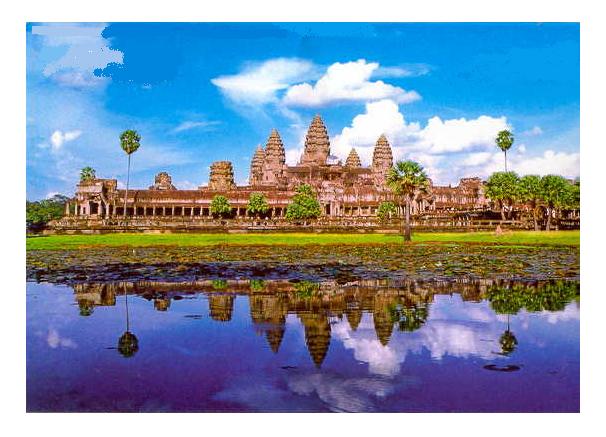
Angkorwat - originally named Vrah
Vishnulok - the sacred
abode of Lord Vishnu.
One
of the most spectacular and mesmerizing structures of astronomical significance that has ever
been built is the temple of Angkor Wat in what is now Cambodia.
"Its
splendid plan, the balance of its proportions, the elegance of its pillared
cloisters and the beauty of its decoration make it one of the masterpieces of
world architecture."
It
is a pity India has forgotten the Angkors. A visit to Siem Reap is essential to
understand Hinduism and to appreciate Indian art.
***
Itself a stupendous work of architecture, the proplylaeum
provides a fitting prelude to the breathtaking vista that expands before one’s
gaze on emerging from its dark, deliberately constricted chambers.
A thousand foot long, raised, processional way, flanked
midway by elegant library pavilions and later by immense reflecting pools –
microcosms of the Cosmic Oceans – leads to a cruciform podium from which the
sovereign could watch processions and the performances of the temple dancers;
and up to the main structure. Here is the apotheosis of the abode of the Devarja,
a temple-mountain of stupendous proportions flaring skyward in a vision of
otherworldly splendor. Each of the terraces of the three-tiered pyramid has
continuous galleries accented with gateways and towers, elaborate stairways, and
the plan is further enriched by additional ‘libraries’ and subsidiary
cruciform galleries.
The miracle of Angkor Wat lies, above all, in the ensemble;
in the fact that these numerous and complex elements have not merely been
combined in an assemblage but have been orchestrated into a stupendous symphony
in stone; that a Euclidean clarity of form in the total layout can be
intuitively sensed by the spectator even if it can only be confirmed from the
vantage point of the gods – or modern man: the air.
Imperial
Scale of Angkor Wat
A sacred site of Angkor, a sprawling
archeological treasure trove covering 250 square miles of jungle in the centre
of Cambodia.
The sculptural decoration of Angkor
Wat, is if anything, even
more astonishing than the architecture. That the main temple alone should
constitute the largest religious building in all history, covering an area as
great as that of the largest pyramids, is astounding enough; that every square
inch of such a structure should be carved and decorated, passes imagination. Yet
so it has been, and with a loving care and skill which have infused the cold
stone with pulsating life.
Angkor Wat, in its beauty and state of
preservation, is unrivaled. Its mightiness and magnificence bespeak a pomp and a
luxury surpassing that of a Pharaoh or a Shah Jahan, an impressiveness greater
than that of the Pyramids, an artistic distinctiveness as fine as that of the
Taj Mahal.
Angkor
Wat, the largest monument of the Angkor group and the best preserved, is an
architectural masterpiece. Its perfection in composition, balance, proportions,
relief's and sculpture make it one of the finest monuments in the world.
The general
appearance of the wonder of the temple is beautiful and romantic as well as
impressive and grand it must be seen to be understood and appreciated. One can never look upon the ensemble of the vat
without a thrill, a pause, a feeling of being caught up onto the heavens.
Perhaps it is the most impressive sight in the world of edifices.

The great
Vishnu temple at Angkor Wat is known to have been built according to an
astronomical plan.
Visitors are amazed at the scale of Angkor City. The complex
covers around 400 square kilometers and comprises over 100 monuments and
edifices of temples, sculptures, statues and incomparable bas-relief that have
withstood the ravages of time.
(image
source: Lost Civilizations - By Austen Atkinson
p. 164).
***
One stands dumbfounded at the mere thought of the labor
involved in the six miles of exquisitely carved moldings on the steps which line
the great moat; or at the ten thousand stone pinnacles of lace-like intricacy
assembled to crown each of the five towers; or the two thousand life-size
reliefs of apsaras, ranged like some celestial corps de ballet, clothed in the
most gorgeous stuffs and sporting unbelievable head-dresses, no two alike; or at
the acres of background ornament, carved to represent the floral patterns. One
of the supreme masterpieces of world sculpture in terms of quality alone, this
bas-relief is some six feet high and over a mile in length.
Exquisitely carved
reliefs

Richly
adorned walls of Angkor wat: The Epic Battle of
Kurukshetra in the Mahabharata.
The sculptural decoration of Angkor Wat, is if anything, even
more astonishing than the architecture.
Arjun and Krishna, his
charioteer. The Bhagavad Gita is the
essence of the symbolic meaning of the battle of Kurukshetra as a conflict
between the sons of Darkness (the Kauravas) and sons of Light (the Pandavas).
Arjuna is the soul of men and Krishna the charioteer of the soul.
Lord Krishna says:
"I am the seed of all things that are; not a being, standing or moving, can
exist without me."
The
Bhagavad Gita has influenced great Americans from Thoreau to Oppenheimer. Its
message of letting go of the fruits of one’s actions is just as relevant today
as it was when it was first written more than two millennia ago.
The
Bhagavad Gita, a world beloved, timeless classic was treasured by American
writers from Emerson to T S Eliot.
(image
source:
webmaster's own collection of photos taken during a recent visit).
***
The themes of the continuous reliefs are taken from
Hindu epics. Particularly noteworthy are the battle scenes from the
Mahabharata and
the Ramayana. At Angkor Wat the great battle between the forces of the
demon-king and the cohorts of the monkey general is depicted with enormous verve
in a monumental composition.
In
this temple, Vishnu's heaven, he was depicted as merciful and compassionate,
despite his mighty power. Deep in cosmic sleep,
he creates a new world. His great deeds of chivalry were described in the
Mahabharata and handed down from generation to generation. They provided the
sculptors of Angkor Wat with subject matter as well as inspiration for their
sandstone canvases.
The most monumental relief and possibly the most
magnificent, is the depicting of Samudra Manthan - ‘the Churning of the Sea of Milk’.
The Gods
and Titans (asuras) though in eternal conflict, formed a temporary alliance to
procure the drink of immortality, amrita or ambrosia. The body of the Cosmic
Serpent, Vasuki, an avatar of Vishnu, was twined around the ‘World Mountain’
Mount Madara placed in the primal void of the ‘Sea of Milk’ and teams of ninety-two demons
and eight-eight gods ranged on either side, grasped the head and tail of the
serpent and enacted a celestial tug-of-war under the direction of Vishnu. They pulled the serpent back and forth and the mountain, pivoted on the
back of the Cosmic Tortoise, Kurma – yet another manifestation of Vishnu –
rotated, acting as a churning stick. As the Milky Ocean turned to butter,
various symbols of power and delight emerged: apasaras, jewels, a milk-white
charger and elephant, and Dhanvantari, the physicians of gods, bearing a bowl of
brimming with amrita.
The proudest of achievements of the
ASI - The
Archaeological Survey of India has been
restoration of the Samudra Manthan Gallery which, had been dismantled by the
French.
***
Samudra
Manthan: Lord Vishnu directing the
Churning of the Milk Ocean.
The Puranic story of the
Churning of the Primeval milk ocean (kshirasagara) by the gods and the demons,
using the primeval serpent, Vasuki, as a rope and Mount Meru as a churning stick
with Kurma, the tortoise as the base.
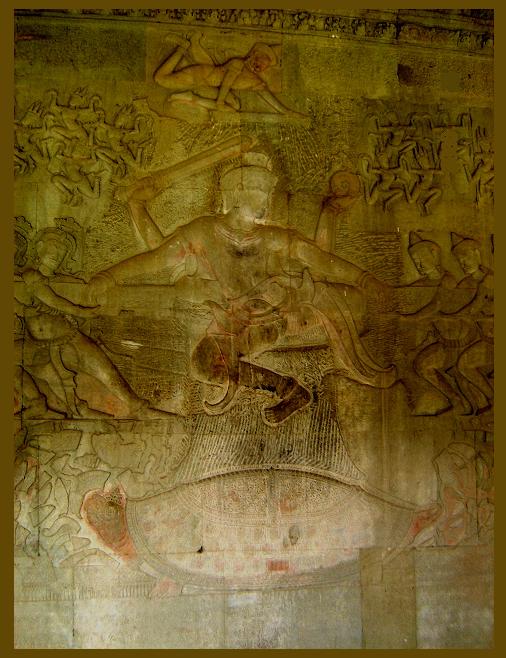
Fluid Elegance of Samudra
Manthan: The Churning of the Milk Ocean.
Lord Vishnu at the center directing the
Churning of the Milk Ocean.
(image
source:
webmaster's own collection of photos taken during a recent visit).
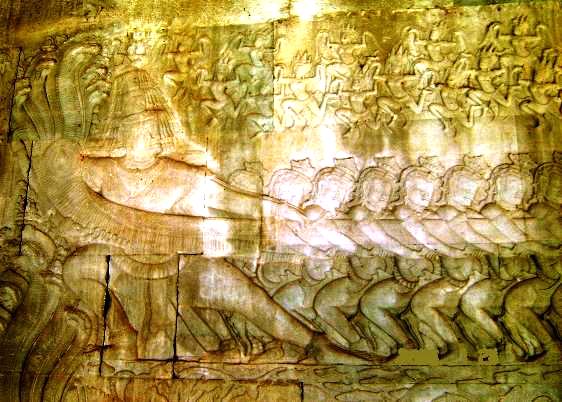
Ravana on the
left as the head of the asuras.
(image
source:
webmaster's own collection of photos taken during a recent visit).

Human on
the right as head of the devas.
The most monumental relief and possibly the most
magnificent, is the depicting ‘the Churning of the Sea of Milk’.
One
of the supreme masterpieces of world sculpture in terms of quality alone, this
bas-relief is some six feet high and over a mile in length.
(image
source:
webmaster's own collection of photos taken during a recent visit).
***
Executed at it was, on a scale of imperial magnificence, the
building of such a structure as Angkor Wat presupposed ‘a high degree of
economic and social integration, plus a government strong enough to command the
labor and talents of vast numbers of trained participants. All told, we are
dealing with a concurrence of favorable circumstances on a vast scale such as
has occurred only a dozen times in world history.
Angkor Wat is the world's largest sacred
building and an architectural masterpiece that took more than thirty years to
build. Angkor
Wat, originally named Vrah Vishnulok - the sacred abode of Lord
Vishnu. For centuries it was known only to locals, existing as a myth for the
rest of the world until the early 1850's, when French explorer Henri Mahout
'rediscovered' the site deep within thick jungle. It would take weeks to view
all of the ruins and truly understand the magnitude of Angkor.
The sight
of the ruins, he wrote in his diary, made the traveler “forget all the
fatigues of the journey, filling him with admiration and delight, such as would
be experienced in finding a verdant oasis in the sandy desert. Suddenly, and as
if by enchantment, he seems to be transported from barbarism to civilization,
from profound darkness into light.” The French (with
their Eurocentric attitude) could not imagine that the Khmer kings were
responsible for such monumental work. The theories as to who
constructed Angkor’s monument ranged from the ancient Romans to Alexander the
Great. Indeed, the structures echo styles from other monumental
ruins. Angkor Wat is built in classical Indian style, and yet the numerous
bas-reliefs have a strangely Egyptian character. The columns and arches at
Preach Khan Temple, evoke those of the Greeks and Romans, while the Pyramid of
Phimeanakas resembles those of the Maya at
Tikal, Guatemala.
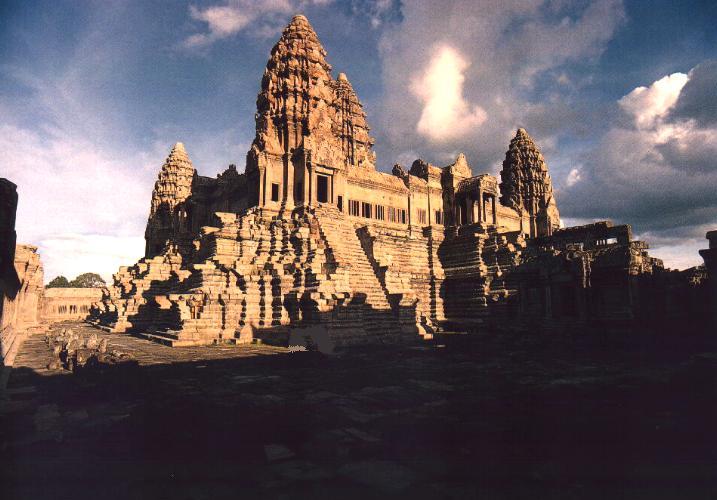
Angkor wat: Hinduism’s patrimony at its most
magnificent.
Angkor
Wat is visually, architecturally and artistically breathtaking. It is a massive
three-tiered pyramid crowned by five beehive-like towers rising 65 meters from
ground level. Angkor Wat is the centerpiece of any visit to the temples of
Angkor.
At the apex of Khmer
political and military dominance in the region, Suryavarman II constructed
Angkor Wat in the form of a massive 'temple-mountain' dedicated to the Hindu God,
Vishnu.
***
If
you are looking for Hinduism’s patrimony at its most magnificent, you won’t
find it within our borders of India.
For that,
you’ll have to take a flight to Bangkok. From there, it’s a short hop to a
rural town in the middle of nowhere in Cambodia. Here in an area that stretches
25 km east to west and 10 km north to south, the local Hindu kings built a
hundred or so temples in praise of Vishnu and Shiva a thousand years ago. The
temple at Angkor Wat is the center piece. It rivals the monuments of ancient
Greece and Rome and is the largest religious structure in the world.
Angkor
Wat is impressive for its majestic scale as well as for exquisite, intricate
details. There are bas-reliefs of scenes from the Mahabharata
and the Ramayana.
An entire stretch of wall has the Kauravas and the Pandavas in furious battle.
On another wall, Vishnu, Shiva, Brahma, Lakshmi and even Hanuman make an
appearance at the churning of the oceans.

An entire stretch of wall has the Kauravas and the Pandavas in furious Battle of
Kurukshetra in the Epic of The Mahabharat.
(image
source:
webmaster's own collection of photos taken during a recent visit).
***
From the ninth to the fifteenth century the Khmer Empire was
the greatest civilization in Southeast Asia, and gave birth to some of the
world’s richest works of art. Inspiration from the magnificent temples and
cities of this period, which contained exquisite carvings in wood and stone
seemingly adorning every nook and cranny, and whose kingdom stretched from the
coast of Vietnam to present-day Thailand. At the heart rose the magnificent
towers of Angkor Wat, now a World Heritage site.
Combining great
technical mastery on an unprecedented scale with extraordinary architectural and
artistic innovations, Angkor Vat has a unique place in the long ancient Khmer
tradition of the royal "Temple-Mountain.". Built in the 12th century
in the reign of King Suryavarman II, this was the residence of Vishnu
The
inspiration for Angkor architecture come from Hinduism. The early rules of
Angkor promoted various Hindu sects, mainly dedicated to Shiva
and Vishnu.


Lord
Vishnu and Lord Shiva
Vishnu and Shiva were later worshipped together as Harihara.
The
inspiration for Angkor architecture come from Hinduism. The early rules of
Angkor promoted various Hindu sects, mainly dedicated to Shiva and Vishnu.
Today
there seems to be an active scheme to de link Hinduism from Angkor wat, much
like the de linking Yoga from Hinduism in the West.
(image
source: Museum Guimet).
***
Visitors
are amazed at the scale of Angkor City. The complex covers around 400 square
kilometers and comprises over 100 monuments and edifices of temples, sculptures,
statues and incomparable bas-relief that have withstood the ravages of time.
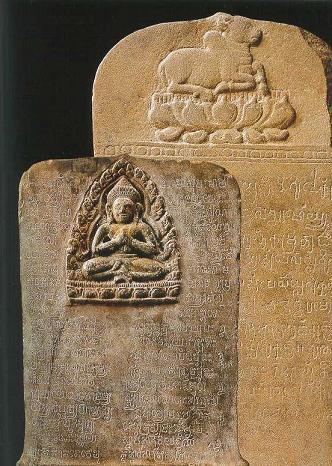 The enormous temple complexes had been expanded to the large area by successive
kings. The
architectural style of Angkor is largely based on Indian (Hindu) cosmology to
symbolize the center of the universe and mixed with local architecture. At the fall of the Empire,
the jungle reclaimed the decaying ruins until being rediscovered in 1861. The enormous temple complexes had been expanded to the large area by successive
kings. The
architectural style of Angkor is largely based on Indian (Hindu) cosmology to
symbolize the center of the universe and mixed with local architecture. At the fall of the Empire,
the jungle reclaimed the decaying ruins until being rediscovered in 1861.
No
photograph can quite capture the immensity of this monument. Some of the
apparent grandeur of the complex is due to clever perspective. The tip of the
central tower is only 65 meters high. However, many of the other statistics of
the temple are still quite impressive. The temple is surrounded by a 200 meter
wide moat (that's more than two football fields to you Americans). The
main temple is built on three levels.
(image source: Angkor: Splendors
of the Khmer Civilization - By Marilia Albanese p. 57).
The first level consists of an open
gallery, with the inner wall continuously covered with bas-reliefs depicting the
Mahabharata, the Ramayana and other
stories from the Hindu pantheon. Its nearly a kilometer walk to see the whole
thing, but its worth it.
Angkor
Wat was built at the height of Cambodian political power in the late 8th century
by King Jayavarman II (802-834),
a fervent follower of Hinduism, he dedicated the temple to God Vishnu.
Angkor
Wat, originally named Vrah Vishnulok - the sacred abode of Lord Vishnu.
The temples were designed to represent Mount Meru, The
name "Angkor" is derived from the Sanskrit word
nagara meaning
"city", successing kings continued the practice of building temple
mountain at the heart of their capital. Angkor Wat is the largest religious
building in the world, it measures more than a half mile long on each side.
Angkor was a metropolis of a million or so people, the capital of Khmer kingdom,
which flourished for 500 years, peaking in the 12th century. Angkor Wat is the
most perfect of the Angkor temples. Built in monumental proportions on three
levels, its symmetrical five tower layout symbolizes the peaks of Mount Meru and
were designed to be a microcosm of the Hindu universe. There is not only the
grandeur, for every spot in the temple is ornamented with sculptures and
bas-reliefs of wonderful detail.
These relics of past grandeur bear
mute testimony tone of the least known yet most glorious chapters in the history
of mankind: that of the classical culture of ‘Greater India.’
(source: Lost Cities of Asia - By Wim Swaan
p. 148 - 160 and p. 13).
Top
of Page
Background of
Vrah
Vishnulok
Architectural Grandeur
Angkor
Wat, originally named Vrah
Vishnulok - the sacred
abode of Lord Vishnu, is the largest temple in the world. It was built by King
Suryavarman II in the 12th century.
Angkor
wat is
often hailed as one of the most extraordinary architectural creations ever
built, with its intricate bas-reliefs, strange acoustics and magnificent soaring
towers.

Angkor
Wat dedicated to Lord Vishnu was originally named Vrah
Vishnulok - the sacred
abode of Lord Vishnu.
(image
source:
webmaster's own collection of photos taken during a recent visit).
***
Angkor Wat is an architectural
masterpiece. Built at the end of the eleventh century by King Suryavarman
II, (reigned from 1113 - 1150 AD) it
is larger than Paris. A shrine dedicated to Lord
Vishnu, it is the largest
religious building in the world and took over thirty seven years to build.
The
layout of its remarkable mathematic design forms a diagram which corresponds
symbolically with the Hindu stories of the creation of the universe.
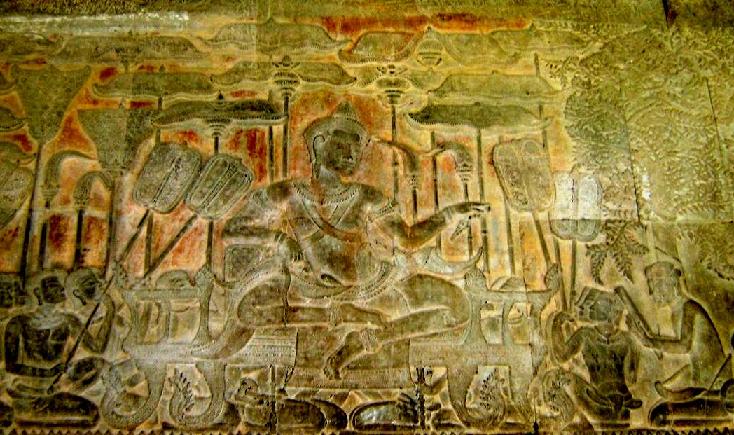
Angkor wat was built by King Suryavarman
II and was dedicated to Lord Vishnu.
Divakarapandita, the
Brahmin in Suryavarman’s service, contributed to its conception and planning.
(image
source:
webmaster's own collection of photos taken during a recent visit).
***
Angkor Wat is the grandest and most
sublime of all Khmer temples. It is the world's largest religious monument. A
completely realized microcosm of the Hindu universe, culminating in the five
peaks of Mt. Meru. It is an architectural masterpiece in fine proportions and
rich in detail; apogee of classical, Khmer construction.
Angkor Wat is the supreme
masterpiece of the Khmer art. The great size, the perfect proportions and the
astoundingly beautiful sculptress everywhere presents itself to the viewer. Its
architecture is majestic and its representation of form and movement from Indian
mythology and epics has astounding grace and power. The temples are designed to teach spiritual knowledge as one
traverses their interior.
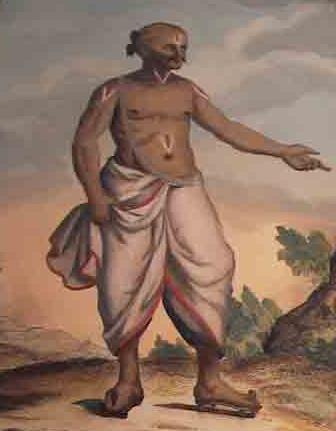 Divakarapandita, the
Brahmin in Suryavarman’s service, contributed to
the conception and planning of Angkor wat. Divakarapandita, the
Brahmin in Suryavarman’s service, contributed to
the conception and planning of Angkor wat.
Divakarapandita was from a long line of illustrious Brahmins, and he must have
been quite old by Suryavarman’s accession, having served the previous two
kings Jayavarman VI and Dharanindravarman I. The building of the temple
commenced upon Suryavarman taking the throne and continued for approximately the
next thirty years.
In 1080, Divakara, a
Brahmin who had been in the service of Harshavarman II, brought a new dynasty to
the throne which was unrelated to the previous one, and crowned the new king
under the name of Jayavarman VI. This king seems to have resided, not at
Yashodharapura, but somewhere farther north, which is probably where his family
came from. Upon his death in 1107, his elder brother Dharanindravarman, was
crowned by the Brahmin Divakara; but five years later his grandnephew, who was
still quite young, seized power and was in turn consecrated as king by Divakara
in 1113 under the name of Suryavaman II.
(source: The Making of South East
Asia - By George Coedes p. 100 – 101).
A variety of legends from Hindu texts are skillfully
illustrated at Angkor wat in the reliefs of the 3rd enclosure.
Angkor
wat’s narrative reliefs clearly refer to popular events from the Epics - The
Ramayana and The Mahabharata and the
Puranas, visually narrated in a way which is generally faithful to the original
Sanskrit texts in terms of the plot – even down to the last detail. Ramayana The
story of Rama is the most widely diffused tale in South and Southeast Asia. In
Cambodia of the Angkorean period, it seems that the Ramayana in use pertained to
Valmiki’s tradition.
The word Angkor is
derived from the Sanskrit word 'nagara' meaning 'holy city'.
Vatika means temple. "The city which is a temple," Angkor Wat is a
majestic monument, the world's largest religious construction in stone, and an
architectural masterpiece.
Cambodia, the ancient Khamboja,
boasts the largest temple complex in the world, named Angkor, from the Sanskrit
language meaning "the capital city." It was built in the 9th century
C. E. in honor of the Hindu god Vishnu. The complex extends over an area more
than twice the size of Manhattan and took thirty-seven years to complete. Its
physical and spiritual grandeur if found elsewhere only in ancient Greece,
Egypt, and among the Mayan and Aztec civilizations. Cambodia's principle river
is today called Me Kong, which is derived from
India's Ma Ganga. It rises
200 feet from the Cambodian jungle floor like a gigantic mandala, its walls
adorned throughout with scenes from the Hindu epic Ramayana and legends of the
god Vishnu and his incarnation, Krishna. Built between the ninth and the
thirteenth centuries by a succession of twelve Khmer kings, Angkor spreads over
120 square miles in Southeast Asia and includes scores of major architectural
sites. In 802, when construction began on Angkor Wat, with wealth from rice and
trade, Jayavarman ll took the throne, initiating an unparalleled period of
artistic and architectural achievement, exemplified in the fabled ruins of
Angkor, center of the ancient empire. According to the poem inscribed on its
walls, the temple at Angkor Wat was not built by humans, but by Celestial
architect commanded by Indra, chief of the gods
The Hydraulic Empire
Angkor
is located at the foot of Mount Kulen, a large natural water-tower from where
many rivers flow down. But water was an irregular resource and the surplus had
to be stored for use in the dry season. The Angkorian
kings understood this and chose to build barays. These were large artificial
reservoirs supplied by rainfall and diverted rivers. They
were well thought out: instead of digging into the ground, people raised dykes
to hold water. Water would enter through the north dyke and would later be
released to irrigate rice fields.
Indratataka,
Sanskrit for "Indra's
basin," was the first baray.
It was built around 880 by
Indravarman I near Roluos, south of Siem Reap. The reservoir was a perfect
rectangle four times longer than wide. The dykes were 2 to 5 meters high, and as
much as 10 million m3 of water was stored there! The Roluos river supplied the
baray, which provided for tens of thousands of people.
A baray is a water reservoir - an area of land
where dikes have been raised to catch and hold water. Angkorian kings built
massive barays, and such projects became one of the marks of Angkorian kingship.
At the center of each baray is an island temple.
The
prosperity of the Khmer state was determined by an unfailing abundance of three
resources: fish, rice, and water. Angkor, the capital of the Khmer empire from
802 to 1431, is well-placed on the northern margin of the Great Lake, to take
advantage of the inexhaustible supply of fish which the lake produces. Equally
important was plentiful water for farming rice. This water was supplied by rains
and rivers, stored in artificial reservoirs, and distributed to the rice fields
by irrigation canals.
Hariharalaya
is the first hydraulic city of classical Angkorian type. The baray of Lolei (Indratataka)
is the first of its kind.
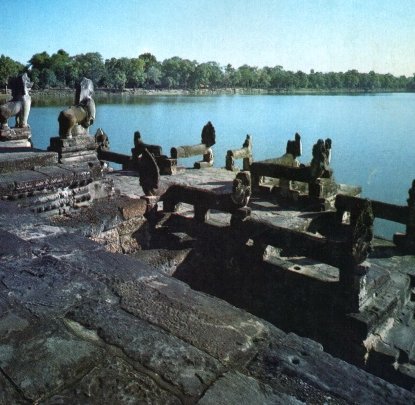 The
first great barays in the Angkor region were Indratataka at Hariharalaya, built
by Indravarman I in the late 9th century, and the East Baray at Angkor, also
begun by Indravarman but completed by his son and successor, Yashovarman I. The
East Baray is a monumental artificial lake measuring 1.8km by 7.5km, which is
1.1 miles wide and 4.7 miles long. As with all the great barays, it was built by
excavating and piling up an enormous earthen retaining wall, about 4m-5m (14')
tall, around the perimeter, so that the water was held above ground behind what
is, essentially, a giant dyke. The East Baray was fed by the Siem Reap river,
and would have held 37.2 million cubic meters of water at a depth of 3m (10').
(A figure of 55 million cubic meters of water is also quoted; the larger figure
assumes an average water depth of 4.5m). The
first great barays in the Angkor region were Indratataka at Hariharalaya, built
by Indravarman I in the late 9th century, and the East Baray at Angkor, also
begun by Indravarman but completed by his son and successor, Yashovarman I. The
East Baray is a monumental artificial lake measuring 1.8km by 7.5km, which is
1.1 miles wide and 4.7 miles long. As with all the great barays, it was built by
excavating and piling up an enormous earthen retaining wall, about 4m-5m (14')
tall, around the perimeter, so that the water was held above ground behind what
is, essentially, a giant dyke. The East Baray was fed by the Siem Reap river,
and would have held 37.2 million cubic meters of water at a depth of 3m (10').
(A figure of 55 million cubic meters of water is also quoted; the larger figure
assumes an average water depth of 4.5m).
The amazing
scale of such a construction, and the amount of labor (about 10,000 man-years)
necessary to dig and pile up the reservoir walls, can hardly be put into
adequate words.
Most likely the water was used for irrigation (this
has been questioned, but recent surveying and satellite imagery seem to confirm
it). Waterworks on this scale must also have had stunning religious and
political implications.
The
major problem with the baray system was siltation - the gradual influx of sand,
carried by the river, into the reservoir. The East Baray was completed around
890. During the next century, as it gradually became filled up with sand, it was
periodically renovated by raising its banks, and new, smaller, barays were
constructed to supplement the water supply (Srah Srang,
east of Banteay Kidei, mid-10th century). The enormous West Baray was completed
in the mid-11th century, followed later by diversion of the Siem Reap river
around the East Baray and into excavated canals. The last great baray at Angkor
was the Jayatataka, built by Jayavarman VII
(1181-1218).
What is now called the
Eastern Baray was the second baray built. Work was completed in the late 10th
century under Yasovarman I's rule. The baray was five times larger than
Indratataka. Just imagine a 7 km-long and 2 km-wide reservoir with dykes 5 to 8
m high! Hundreds of thousands of people could be supplied with water. The
Eastern Mebon, a temple-mountain dedicated to Lord
Shiva, was completed later on in
953. Located in the center of the reservoir, it used to be accessible only by
boat.
The
Khmer had developed an elaborate irrigation system of canals, dikes, moats, and
large reservoirs. The water was drawn from the Tonle Sap, Cambodia's
huge central lake, which floods 'every year during the rainy season. In the
1960s, the French archeologist Bernard-Philippe Groslier made a series of aerial
photo-graphs of the district, revealing that the Khmer had harnessed the lake's
flooding cycle, filling upland reservoirs to insure abundant rice crops each
year.
Agronomists rate this thousand-year-old irrigation system higher than any
used by modern Cambodians.

Map of Angkor with its barays.
(image source: www.art-and-archaeology.com).
***
Srahs and barays were reservoirs,
generally created by excavation and embankment respectively.
(source: online sources).
Also
refer to The
application of microwave scattering mechanisms to the study of early Angkorean
water management
The
laterite bridge of Kompong Kdei, known as Spean Praptos, is one of the most
impressive of the Khmer barrage-bridges. It dates from the first half of the
13th century and is 285 feet (87 meters) long. The arches are very
narrow because of the method of construction by a system of corbels. The
architect Jacques Dumarcay has shown how
these arches could be fully or partially closed in order to contain the water
upriver from the bridge. This method of irrigation, where a noria was needed to
contain the water subsequently used to irrigate the surrounding fields, was very
different from the barray system. At the end of the bridge, there is the head
and the tail of a snake with 9 heads, the naga. The bridge of Kompong Kdei built
with ramparts forming a very long snake.
(source:
Khmer: The Lost Empire of Cambodia - By Thierry Zephir
p. 21).
Without
doubt, the largest existing bridge from the Angkorean period, its a fantastic
piece of engineering, with 21 laterite arches, its 85 metres long and is topped
by an original naga balustrade and four massive naga heads. How these are still
in their original location is a miracle but they are well worth investigating,
as is the bridge itself.
By founding his capital at Rouluos, just southeast of Angkor,
in the middle of an arid plain annually plagued by drought and flash floods,
Jayavarman II bequeathed to archaeologists and other scholars a geo-climatic
conundrum. What possessed him to site the nerve-center of Khmer civilization at
such an environmentally unfriendly spot and how did the great city sustain
itself through the centuries? Archaeologists
have postulated that the Khmers engineered a complex irrigation system to grow
enough rice to feed the city's population. In this view, Angkor was a classic
hydraulic society.
In the Art of Southeast Asia, Philip
Rawson writes:
"Angkor was a capital, filled with temples and
supporting many inhabitants. But its nucleus was a splendid
irrigation project, based on a number of huge artificial reservoirs
fed by the local rivers and linked to each other by means of rectangular grid
system of canals. "The barays, or man-made lakes, were used to feed an
intricate network of irrigation channels. The first baray was Lolei, built by
Indravarman at the city of Rolous. "The engineering involved at
Angkor," Rawson says, "was vaster and far more sophisticated than
anything seen before in that part of the world." Lolei was more than 3 ½
km long and 800 m wide. The East baray was twice the size of Lolei and the West
Baray, built during Udayadityavarman II's reign is thought to have held about
four million cubic meters of water when full.
(source:
Art of Southeast Asia - By
Philip Rawson p. 44 - 45).
A
Sanskrit inscription compares the reservoirs
of Angkor with the Ganges and its tributary in India, where they meet at the
site of Prayag, the ancient city where Allahabad now stands:
"Prayag
should be approached with the respect worthy of its proximity to the two holy
waters. What can we then say of the city of Jayasri, made illustrious by the
holy waters consecrated to Shiva and Vishnu and the Buddha?"
(source:
Angkor: The Hidden Glories - By Michael Freeman and
Roger Warner p. 122).
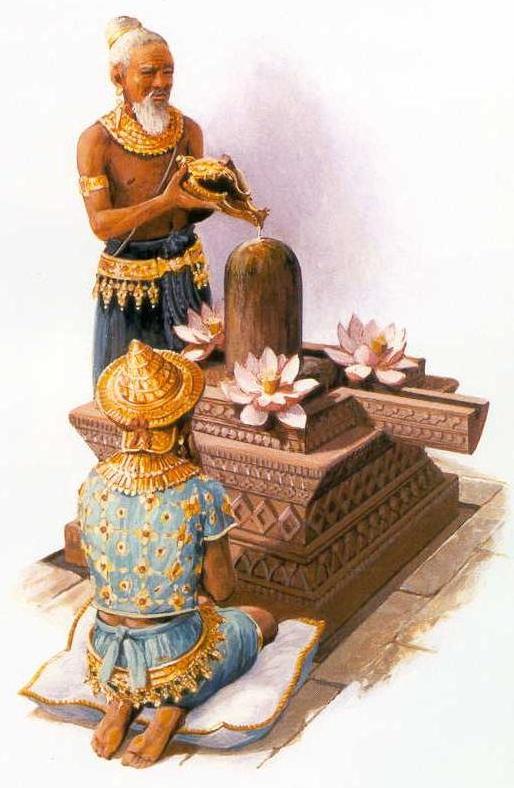
Shiva Linga: the symbol of the
creative potency of God.
"On the crest of this
mountain of gold, in a temple of gold, shining with celestial brilliance, he
erected a linga of Shiva, honored with ablutions at the prescribed times."
Kneeling in reverence, a Khmer
Monarch pays homage to Lord Shiva while his personal Brahmin pours an offering
of ghee over a stone lingam. The Shiva lingam symbolized Shiva as the source and
creator of all life.
(image source: Splendors
of the Past: Lost Cities of the Ancient World
- National Geographic Society p. 197).
For
more on Lord Shiva refer to chapter on Symbolism
in Hinduism.
***
The Royal Roads in the Khmer Empire
The Khmer rulers placed great
priority on communications within the empire, and one of the great
accomplishments was the network of roads fanning out from the capital. These are
mentioned in several inscriptions, and although over much of their length the
actual highway has disappeared, the routes can be traced by means of various
constructions – bridges, rest-house chapels and hospital chapels, particularly
from the reign of King Jayavarman VII.
In addition, maps and aerial photography reveal some
stretches. One of the most important of the royal roads was that connecting
Angkor to Phimai, about 225 km in length. Others ran from the capital to Beng
Mealea and Preah Khan of Kompong Svai to the east, to Koh Ker and probably on to
Champa (to the north-east), to Kompong Thom and Sambor Prei Kuk (to the
south-east), and towards present day Sisiphon (to the west). Although the
bridges and chapels, and much of the highway construction, belong to the reign
of Jayavarman VII, some of these roads must have been in use long before, simply
because of the dates of the cities and temples they connected.
The royal road to Phimai almost certainly existed at the time
that King Suryavarman II came to power at the beginning of the 12th
century, and probably considerably earlier. Phimai was then a major center, and
the road had both military and trade importance. Today, the only part of the original
road that is drive able is Route 2163 that enters the town of Phimai in
Thailand.
(source: A Guide to
Khmer Empire in Thailand and Laos - By Michael Freeman p. 154).
Top
of Page
Breath
Taking Carved Bas-Reliefs
Graphic
Eloquence
John
Audric ( ? ) has observed: "The
bas-reliefs are one of Angkor Wat’s greatest treasures and
outstanding attractions. In the lower terrace they
continue for over half a mile, which gives some idea of the
vastness of the temple. Every stone is decorated. The bas-reliefs
are about 8 feet high. The whole effect is that of an almost
endless tapestry in stone. The subjects are principally religious,
of legends and of war.
"The
scenes from Ramayana and Mahabharat
take up nearly half a mile, and the total number of figures of
men, animals and birds has been calculated to be nearly 20,000.
There are combats between opposing forces who are mounted on
elephants. Hundreds of elephants have been sculptured on the
walls, and illustrate some incidents from these two epics;
warriors fighting from chariots, scenes from the lives of the God
Rama and his wife Sita, who was kidnapped by the demon Ravana,
armies of men and monkeys. Vast stretches depict Khmer victories
on land and sea, naval pageants, victory marches with bands and
banners. The God Vishnu is mounted on a garuda; there are
invocations to the Hindu trinity, goddesses, and guardian deities."
The
sculptors were fortunate in being provided with a most sensitive,
ideal and endless canvas upon which to exercise their talents.
This was polished sandstone. They used about 4,000 feet of it. The
bas-reliefs decorate eight panels, four of which are over 100
yards long. Everything
about Angkor Wat is on a massive and lavish scale, as if time,
expense and labor were of little importance. The bas reliefs in
the majority of cases are executed with exquisite beauty, and the
most minute attention to detail, symmetry and proportion."
(source:
Angkor and the Khmer empire - By John
Audric p. 139 - 140).
Reliefs carved in
stone are among the greatest artistic achievements of the Khmers. Narrative
scenes inspired by the great Hindu epics, the Ramayana and the Mahabharata,
sacred books and military history of the period unfold on the walls of temples
conveying sublime beauty, majesty and humour. The reliefs surpass the function
of portraying events; they transform the temples into celestial dwellings.
Angkor Wat, the greatest of Khmer
temples, is a text in itself. The hundreds of reliefs sculpted on its stones
narrate the events from the Hindu Epics - Ramayana and Mahabharata and the
Puranas, and symbolically communicate the fundamental religious, philosophical,
ethical and political principles of the Khmer at the time of King Suryavarman
II.
The artistic quality of the etched narrative –
much of it from the Hindu Ramayana, with its titanic wars fought by men and gods
in the guise of animals – is breathtaking.
Although there is no evidence
identifying the architects of the temple, it is likely that Divakarpandita,
the Brahmin in Suryavarman's service, contributed to its conception and
planning. Divakarpandita was from a long line of illustrious Brahmins, and he
must have been quite old by Suryavarman's accession, having served the previous
two kings Jayavarrman VI and Dharanindravarman I.
The entire temple is richly
decorated with splendid reliefs, mainly of the narrative type which are visual
retellings of episodes from the two Sanskrit Epics the Mahabharata and the
Ramayana and the Puranas, and as such, they can be considered a narrative genre
in their own right. The proliferation of narrative reliefs in Cambodia since
Agkorean times suggests that they had become a popular device for communicating
religious beliefs and historic events through the medium of 'stone
writings.'
The large relief panels of the galleries of the 3rd
enclosure are the first narrative reliefs, that one encounters when entering the
temple. They surprised the first explorers and still astonish the modern
visitor. Due to their great beauty and rich narrative content, they made Angkor
Wat famous. The Large Panels, are sculpted in the long galleries forming the
rectangular perimeter of the temple proper, and on entering the enclosure they
immediately engage the eye, drawing the visitor along the galleries. The
panels’ dimensions are enormous, ranging from 48.35 to 93.60 meters in length
and of over 2.40 meters in length.
Unquestionably, the Large Panels are, together with the
reliefs from the western corner pavilions,
an outstanding contribution to the sacredness of Angkor Wat.
Description
of the Reliefs
The
Epics of Ramayana and Mahabharata have both contributed in a big
way to enrich the folklore of not just India but most of South
east Asia.
According to Sir C Rajagopalchari,
the first Indian Governor General of Independent India,
Mahabharata and Ramayana are noble poems transcending national and
religious frontiers, and belong to the whole world and human
family. They possess in supreme degree the characteristics of a
true epic, great and fateful movement, heroic characters and
stately diction.

According to Sir C Rajagopalchari, the first Indian
Governor General of Independent India, Mahabharata and Ramayana
are noble poems transcending national and religious frontiers, and
belong to the whole world and human family.
Both Ramayana and Mahabharata are not mere epics but
romances too, telling the tales of heroic men and women, and of
some who were divine.
(image
source:
webmaster's own collection of photos taken during a recent visit).
***
Both Ramayana and Mahabharata are not mere epics but romances
too, telling the tales of heroic men and women, and of some who
were divine. The contain a code of life, a philosophy of social
and ethical relations, speculative thought on human problems that
are hard to rival. Above all, they carry divine wisdom through the
lives of human folks, like us and not super humans. Both epics are
symbolic of the duality of nature: earh-water, day-night,
love-hate, comfort-pain, sweet-sour, truth-falsehood,
violence-non-violence, good-evil, peace-war, and so forth.
A
variety of Indian sacred stories and legends from Hindu epics are skillfully
illustrated at Angkor Wat in the reliefs of the third enclosure.
***
The
Mahabharata Gallery:
Battle of
Kurukshetra
The Hindu epic,
the Mahabharata, describes the struggle between the Pandavas and the Kauravas,
two rivals, who in the climax, fight the Battle of Kurukshetra in northern
India.
 
The Kauravas advancing from the left
and the Pandavas from the right.
The
Epics of Ramayana and Mahabharata have both contributed in a big
way to enrich the folklore of not just India but most of South
east Asia.
(image
source: Splendors
of the Past: Lost Cities of the Ancient World - National
Geographic Society. p. 197).

The Epic Battle of Kurukshetra.
The Hindu epic,
the Mahabharata, describes the struggle between the Pandavas and the Kauravas,
two rivals, who in the climax, fight the Battle of Kurukshetra in northern
India.
(image
source:
webmaster's own collection of photos taken during a recent visit).
***
Sculpted in a single panel 48.35
meters in length along the southern wing of the western gallery, this relief has
been divided into two symmetric halves on the side nearest the western entracne
of the 3rd enclosure is grouped the Kaurava army, while on the other, southern
side, are the Pandavas. On the side of the Kauravas there appear to be 44 large
figures, while on the Pandavas 27 leaders on chariots, in addition to two
mounted on elephants and three or five on horses.
Grandsire Bhishma is
seen having renounced fighting at the end of the tenth day, as he is lying on
Sharashayya, ‘bed of arrows, with five Pandavas to the right sitting in
prayer.
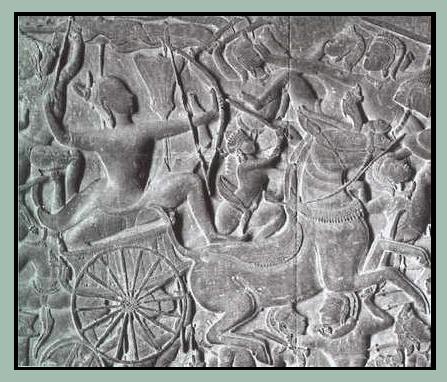
Dronacharaya, teacher of the
military arts.
(image source: Sacred
Angkor: the Carved Reliefs of Angkor wat - By Vittorio Roveda).
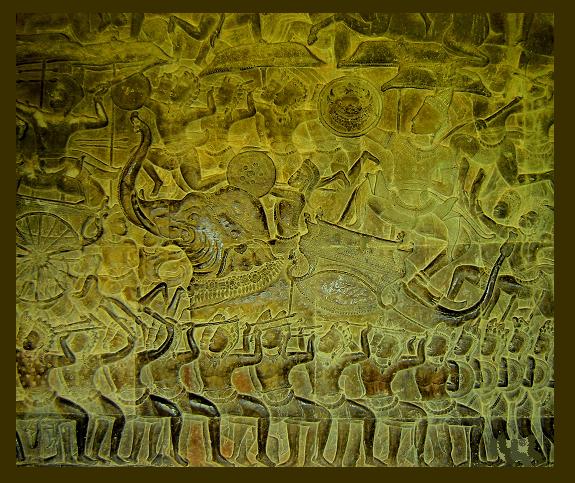
Bhima on his mount - the
elephant.
(image
source:
webmaster's own collection of photos taken during a recent visit).
***
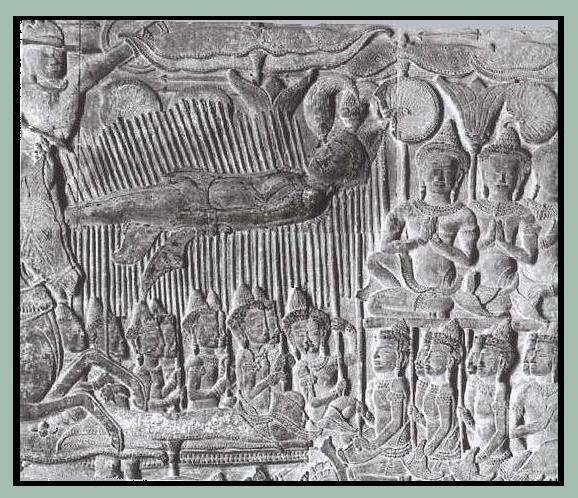
Grand Patriarch Pitamah Bhishma on sarasayya
bed of arrows.
Most striking is the image of
Pitamah Bhishma, the general-in-chief of the Kaurava army, wounded by hundreds of arrows
shot by Arujuna heading a group of the Pandava army. He is so skewered with
arrows that his body does not touch the ground, and to provide him with a head
support, a 'warrior's cushion', as he calls it, Arjuna shoots three arrows into
the ground.
(image source: Sacred
Angkor: the Carved Reliefs of Angkor wat - By Vittorio Roveda).
***
Most striking is the image of
Bhishma, the general-in-chief of the Kaurava army, wounded by hundreds of arrows
shot by Arujuna heading a group of the Pandava army. He is so skewered with
arrows that his body does not touch the ground, and to provide him with a head
support, a 'warrior's cushion', as he calls it, Arjuna shoots three arrows into
the ground. Bhishma survives until after the battle, choosing the auspicious
time for his death. You see Dronocharaya, with his hair tied back in a topknot
and wielding a bow, leads the Kauravas after Bishma's fall.
Two meters further
on, near the bottom, Karna turns round in his chariot and tries to free the
stuck wheel; as he does so he is killed by Arjuna, whom you can see 4 m beyond
and near the top, at the head of the Pandava army, firing an arrow from his
chariot. His charioteer has four arms, identifying him as Krishna (an avatar of
Lord Vishnu).
The battle ends after 18 days, with
all combatants killed signifying the end of that yuga, or world cycle. The
entire army and all Kaurava brothers themselves have been killed, signifying
victory of Dharma (goodness, righteousness and truth) over Adharma (evil,
injustice and lie).

Troops celebrating their
victory after the battle of Kuruksetra in the Epic of the Mahabharata.
(image
source: Splendors
of the Past: Lost Cities of the Ancient World - National
Geographic Society).
***
Churning of the
Milk Ocean
This relief,
perhaps the most famous is sculpted in the southern wing of the eastern gallery,
extending 48.45 meters along its wall.
Taken from the
Bhagvata Purana, this great Hindu creation legend is here spectacularly
realized in one continous 49 meter panel. By pulling alternately on the body of
the giant naga Vasuki, which is coiled around Mount Mandara, the gods and asuras
rotate the mountain for 1,000 years to churn the cosmic sea - the Sea of Milk -
and so produce amrita, the elixir of immortality.
In the event, this cooperation
between gods and asuras is shattered as soon as the amrita begins to be
produced. The gods go back on their promise to give half to the asuras, who then
try to steal it. The scene shown here, is the actual churning.
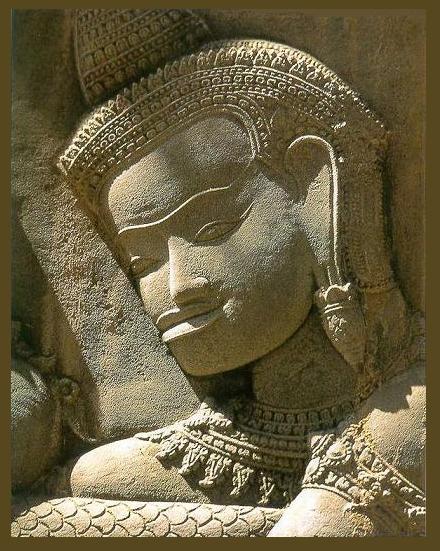
Deva Churning the ocean.
© Michael Freeman (image
source: Ancient
Angkor - By Michael Freeman and Claude Jacques p. 63).
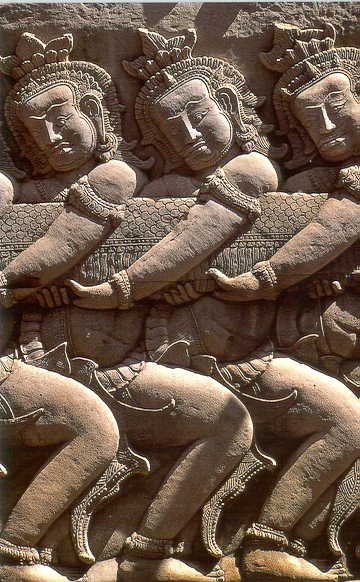
Asuras pulling on the
serpent.
© Michael Freeman (image
source: Ancient
Angkor - By Michael Freeman and Claude Jacques p. 62).
***
For the first five meters, the army
of asuras is lined up with horses and elephatns; the churning begins directly
after this, the you see is a giant multi-headed asura - Ravana holding the five
heads of the giant naga Vasuki. Beyond him stretches the team of 92 asuras
pulling in unison on the serpent body. The cosmic sea is represented by a
swirling mass of marine life, caught up in the turbulence. The marine life also
includes many kinds of fish, crocodiles, dragons, nagas, and turtles.
Close to the center of the panel, in
the middle, on the pillar like Mount Mandara, four armed Vishnu directs
operations. He also appears below, as his turtle avatar - Kurma, supporting the
rotating mountain as it threatens to sink below the sea. Also tiny images of the
elephant Airavata, and the horse Ucchaissravas, both created by the churning.
The presence of Ravana and Hanuman on either side is quite unique and not part
of the original legend. It represents the Khmer combining the ancient Vedic
legend with characters from the Ramayana.
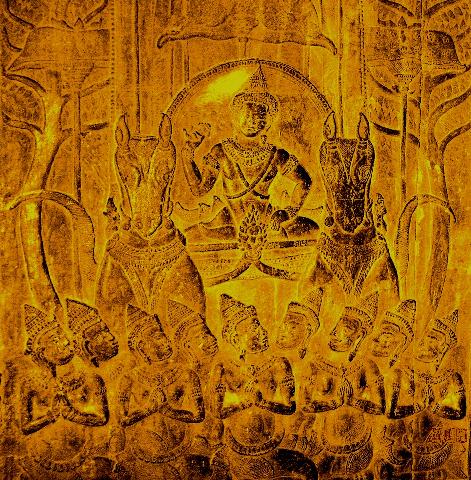
Surya on his chariot.
(image
source:
webmaster's own collection of photos taken during a recent visit).
***
The
Ramayana
This story of Rama is the most widely diffused tale in South
and Southeast Asia. It is the best loved and most widely told of all Hindu
legends, and is an epic of the triumph of good over evil, which remains very
popular in Southeast Asia. Ramayana, which predates the Mahabharata, was written by sage
Valmiki in Sanskrit and was later on, during medieval times, rendered into Hindi
poetry by Tulsidas. In the Cambodian of the Angkorean
period, it seems that the Ramayana in use pertained to Valmiki’s tradition.
The stele of Veal Kantel of the VII century mentions that the Ramayana had to be
recited daily, without interruptions, as were the Harimvamsa and the Puranas.
Ramayana is the story of a Royal house-hold, of King Dasaratha of the Solar
dynasty ruling over Kosala.

Lord Ram shooting the golden
deer.
(image
source:
webmaster's own collection of photos taken during a recent visit).
***
According
to Sir C Rajagopalchari, the first Indian
Governor General of Independent India, Mahabharata and Ramayana are noble poems
transcending national and religious frontiers, and belong to the whole world and
human family. They possess in supreme degree the characteristics of a true epic,
great and fateful movement, heroic characters and stately diction. Both Ramayana
and Mahabharata are not mere epics but romances too, telling the tales of heroic
men and women, and of some who were divine. The contain a code of life, a
philosophy of social and ethical relations, speculative thought on human
problems that are hard to rival. Above all, they carry divine wisdom through the
lives of human folks, like us and not super humans. Both epics are
symbolic of the duality of nature: earth-water, day-night, love-hate,
comfort-pain, sweet-sour, truth-falsehood, violence-non-violence, good-evil,
peace-war, and so forth.
The Svayamvara of
Sita
Located on the east wall of the
southern arm, this relief depicts the test that would be suitor must undergo in
order to win Sita's hand (svayamvara). To the left of Rama is a princess
decpticted wearing the 3 pointed mukuta, typical of a lady of royal status. Sita
is seated on a richly decorated throne; to her side there is a large casket in
the shape of a lotus. She is adorned with jewelry and her sarong ends in a
pointed flap. In her left hand she gracefully holds a lotus bud. She does not
seem to be watching Rama, but instead gazes at the viewer. Many court ladies
surround her, some holding fans, others with one arm over their chests. On the
other side of Rama is a brahmin/sage identified by his chignon and beard. He is
Vishwamitra, Rama's guru. Sita's father King Janaka, is seated on a high base of
his court. Behind him are royal servants with fans. In the relief, the
competition target is a bird perched on a wheel on a tall pole. Such a target is
not described in Valmiki's Ramayana. Rama performs the archery test. Sita waits
to be given in marriage to him and royal personages witness the event.
King Janaka, Sita’s fathr, had an antique bow of Shiva at
his palace which was so heavy that it could not be lifted by ordinary warriors.
He decided to marry Sita to only that prince who could cast an arrow from his
bow. Accordingly, a swayamvara was organized and princes from far and near,
including Ravana, came in the hope of wedding Sita but no one could even shake
the bow. Many princes together tried to lift the bow but failed. Ultimately,
Vishwamitra permitted Rama to end the gloom which had spread in the palace
thinking Sita could not be wed. In the bas relief Rama is seen pulling the arrow
on the target from Shiva’s bow. Sita is sitting on the left. Other kings are
looking in admiration.

Sita Svyamvara: Lord Ram breaking
the bow in the Ramayana. Richly
decorated with reliefs from Hindu Epics.
(image source: Sacred
Angkor: the Carved Reliefs of Angkor wat - By Vittorio Roveda).
***
Battle of Lanka
The reliefs of the northern portion of this
western gallery illustrate a renowned episode of the Ramayana, the Indian epic
tale which recounts the exploits of Prince Rama (an avatar of Vishnu). We see
here the Battle of Lanka, in which Rama's monkey army led by the monkey General
Hanuman fights the Demon King Ravana's army. Rama's army seeks to rescue his
wife Sita, who has been captured and held hostage in Lanka, Ravana's island
kingdom.
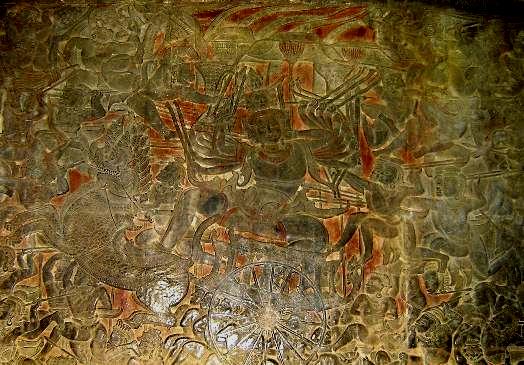
Ravana in battle with Lord
Ram.
(image
source:
webmaster's own collection of photos taken during a recent visit).
***
The sequence of this bas-relief depicts battle between Rama
and Ravana. This is one of the best executed panels, as the figures are
exquisitely carved, especially the depiction of monkeys fighting with the
soldiers of Ravana. The ferocious fight between monkeys and the enemy is seen
all over, and then suddenly at the ninth bay the graceful figures of Rama and
Lakshmana stand.
The Battle between the Devas
and the Asuras
The Western wing of the northern gallery is given
over to a great battle between the devas and asuras extending for 93.60 meters.
Hinduism greatest deities shown in heroic posture and size, riding their mounts.
Vishnu/Krishna on Garuda, Indra on Airavata, Yama on his buffalo, Skanda on his
peacock, Agni on his rhinoceros.

Yama: Lord of
Death on his buffalo.
(image source: Sacred
Angkor: the Carved Reliefs of Angkor wat - By Vittorio Roveda p.
47)..
***
The
rest of the chapter continues at the link listed below:
Sacred
Angkor part 2
Sacred
Angkor part 3
Sacred
Angkor part 4
Top
of Page
 Did You
Know? Did You
Know?
India's
presence in Cambodia
ASI (The
Archaeological Survey of India)
set to renovate temple in Cambodia
The
ancient Ta Prohm (Grandfather Brahma) temple in Cambodia will be restored to its pristine glory,
thanks to a new proposal envisaged by the Cambodian government involving Indian
agencies.
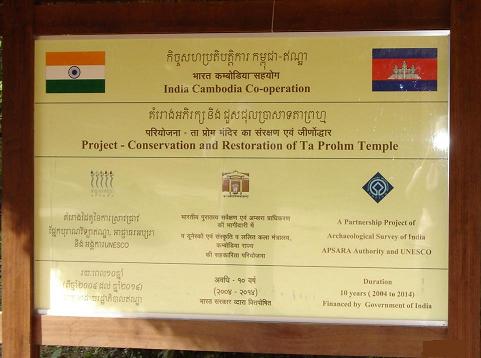
The
Ta Prohm temple which was constructed in 1139 is situated in the
Siemreap city of Cambodia.
The temple is dedicated to Lord Brahma among other Gods.
(source:
webmaster's own collection of photos taken during a recent visit).
***
The
ancient Ta Prohm temple in Cambodia will be restored to its pristine glory,
thanks to a new proposal envisaged by the Cambodian government involving Indian
agencies.
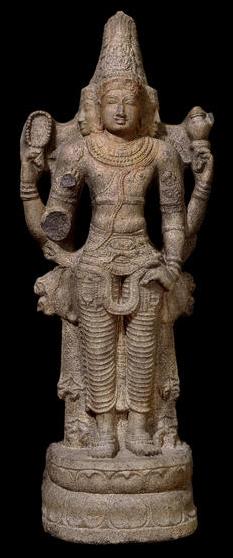 For the restoration work at the Ta Prohm, which is dedicated to Hindu gods and
goddesses, the Cambodian government has roped in the Archaeological Survey of
India (ASI) and the Forest Research Institute (FRI), Dehra Dun. For the restoration work at the Ta Prohm, which is dedicated to Hindu gods and
goddesses, the Cambodian government has roped in the Archaeological Survey of
India (ASI) and the Forest Research Institute (FRI), Dehra Dun.
While the restoration work on various idols would be undertaken by the ASI, the
preservation of scores of ancient trees in the vicinity of the temple complex
would be done by the FRI. The
FRI, which is one of the world’s largest institutes of its kind, will
undertake a foreign assignment for the first time. “We have been asked to
conserve the trees inside the temple complex,” Dr S S Negi, Director of the
FRI said.
There are an estimated 250 ancient trees in the temple complex here, Dr Negi
added.
The Ta Prohm temple — which was constructed in 1139
— is situated in the Siemreap city of Cambodia. The temple is dedicated to Lord
Brahma among other gods.
The FRI has developed its expertise in silviculture and documented nearly 550
tree species in Asia. A team of experts from the Forest Research Institute would
be travelling to Cambodia next week, Dr Negi said.
(source:
ASI
set to renovate temple in Cambodia - deccanherald.com).
***
Vajpayee
tree amid Cambodian temple ruins
Angkor Wat (Cambodia), Dec 7 2002: Shaped like a
dancer's body, a 200 -year-old tree standing tall amidst the Ta Prohm ruins near
the historic Angkor Wat temple site has a special connection with India.
It is called the Vajpayee
Tree, after former Indian prime minister Atal Bihari
Vajpayee.
"Everyone here calls it the Vajpayee Tree," said Pradeep
Kumar Kapur, India's ambassador to Cambodia. "Earlier it was called the
Dancing Tree because it is shaped like the body of a dancer." But then
Vajpayee came to the site in 2002, on a visit to Cambodia, and the name changed.
"He had become very poetic under this tree, very touched, very moved by its
beauty and since then the tree has been called Vajpayee Tree. "Everyone calls it by that name."
The
Archaeological Survey of India (ASI) is helping Cambodia conserve the 13th
century Ta Prohm, a bit of which crumbles every monsoon, for around a decade
after it helped clean up and conserve the ancient Angkor Wat monuments.
An ASI
team is working in the ruins of the temple built by King
Jayavarman VII which was essentially a sprawling
monastic complex.


It is called the
Vajpayee
Tree, after former Indian prime minister Atal Bihari
Vajpayee.
***
"India
is providing around $4.2 million to help conserve this complex," said Kapur,
as he showed participants of the first India-ASEAN rally, as it passed through
Cambodia on its 20-day, eight-nation journey, around the ruins filled with
images of Lord Vishnu and dancing celestial beauties.
"We are working to maintain this unique and wonderful heritage."
India had spent $4 million on the restoration work of the Angkor Wat during
1986-93. "Last time, we cleaned the moss that was growing on the
stones," said Chandra Mohan Bhandari, former Indian ambassador to Cambodia
and author of "Saving Angkor".
"It is because of our work that a lot of the Angkor monuments could be
saved."
Ta Prohm is only partially cleared of jungle overgrowth. Massive fig and
silk-cotton trees grow from its towers and into its corridors giving a unique
trees- merging-into-temples look. Flocks of noisy parrots flit from tree to
tree, sometimes sitting on the gaping holes on the walls, where precious stones
once sat. Enormously wealthy in its time, Ta Prohm controlled 3,000 villages and
a population of almost 80,000 people. "We are doing our best so that the
splendour of this monument is kept intact," said Kapur.
(source: Vajpayee
tree amid Cambodian temple ruins - msn.co.in).
Top
of Page
The
rest of the chapter continues link listed below:
Sacred
Angkor part 2
Sacred
Angkor part 3
Sacred
Angkor part 4


|